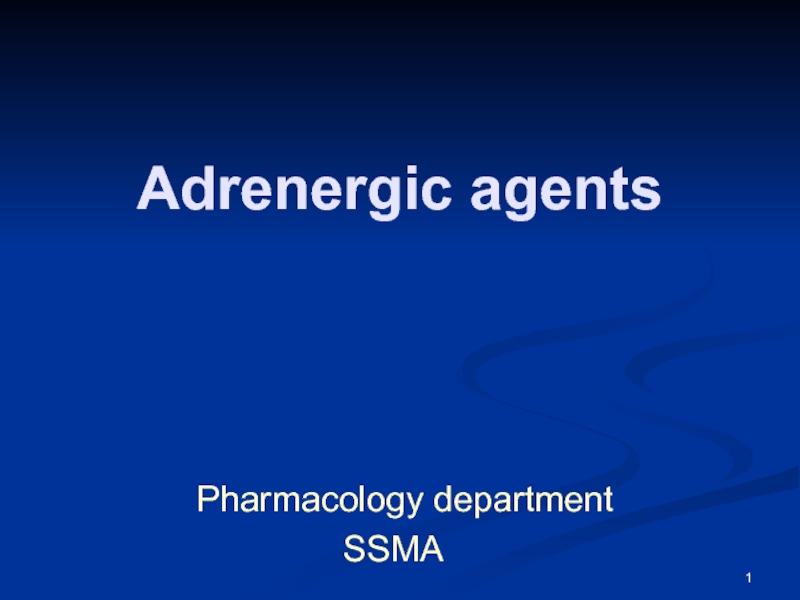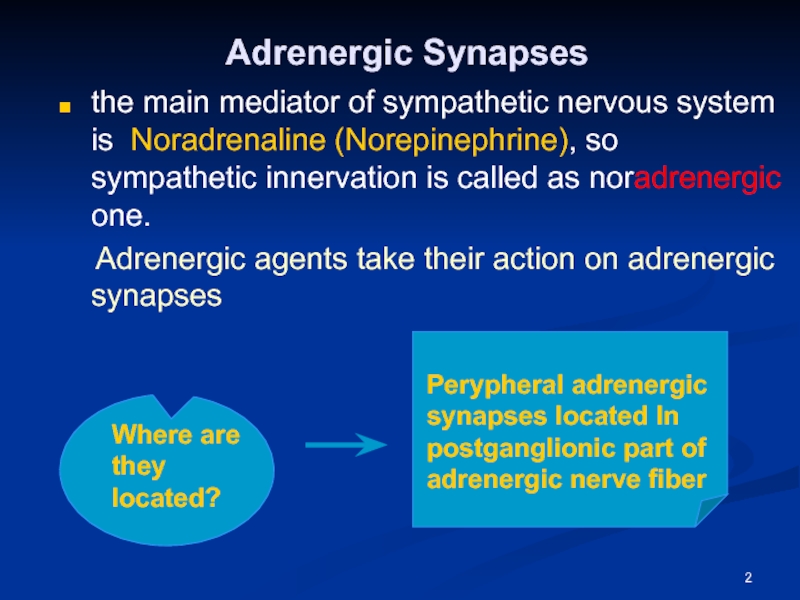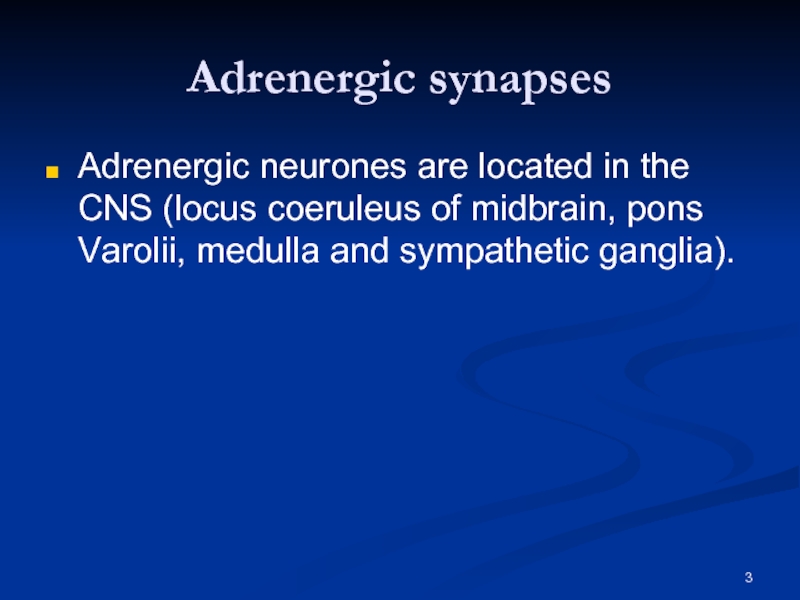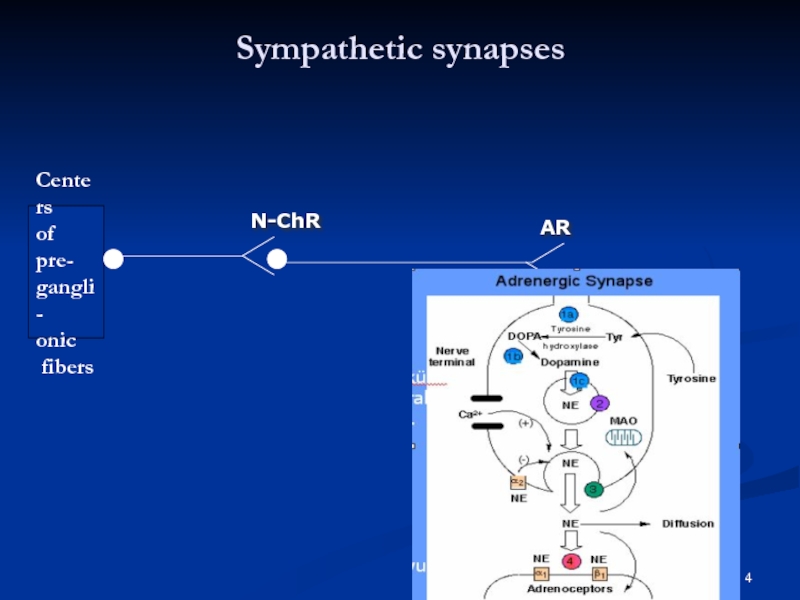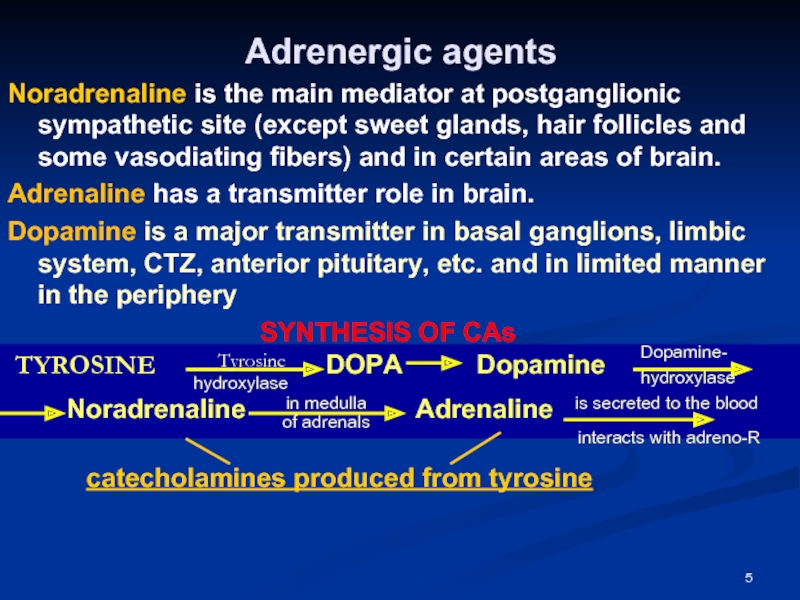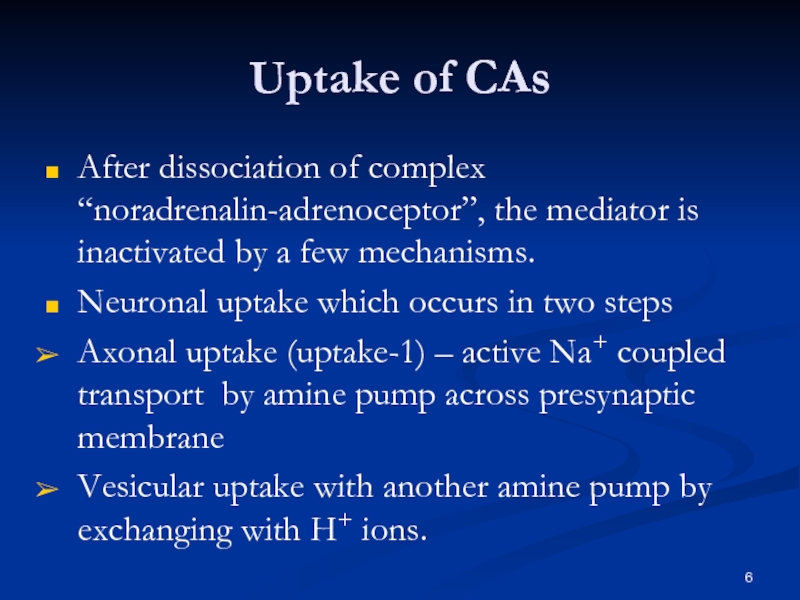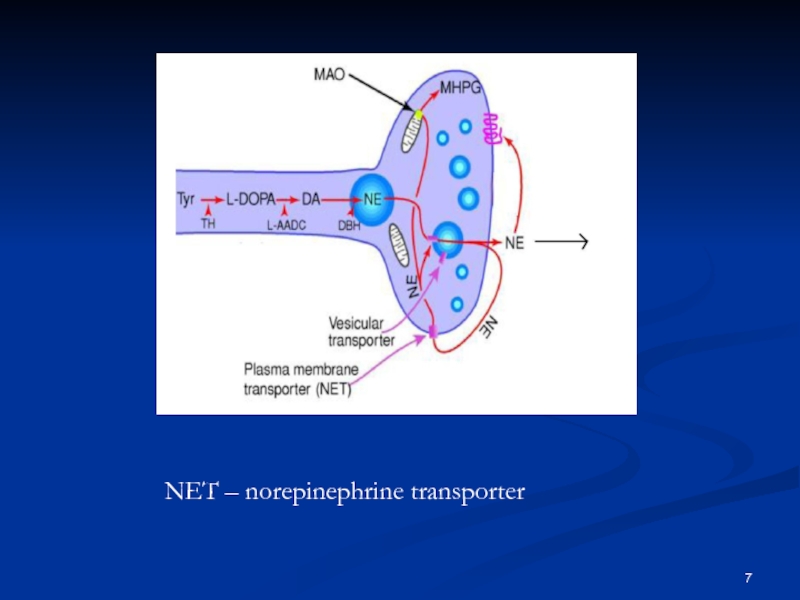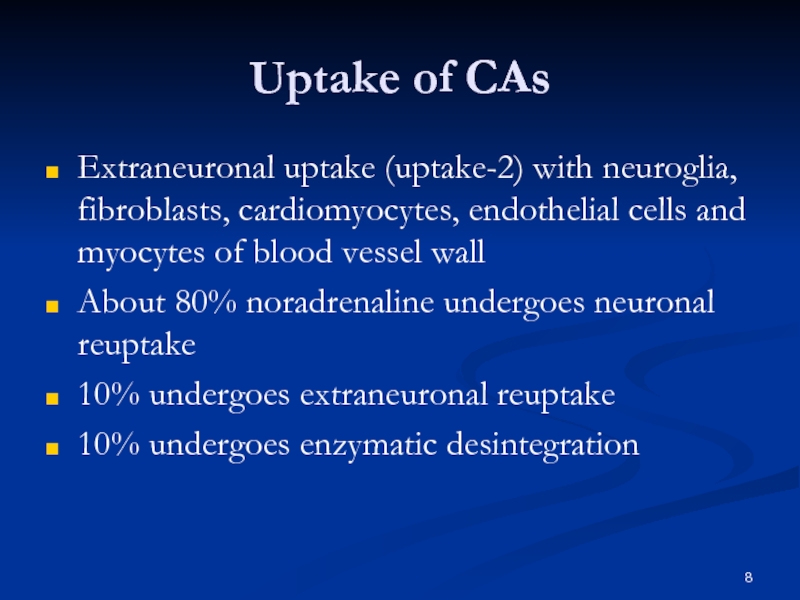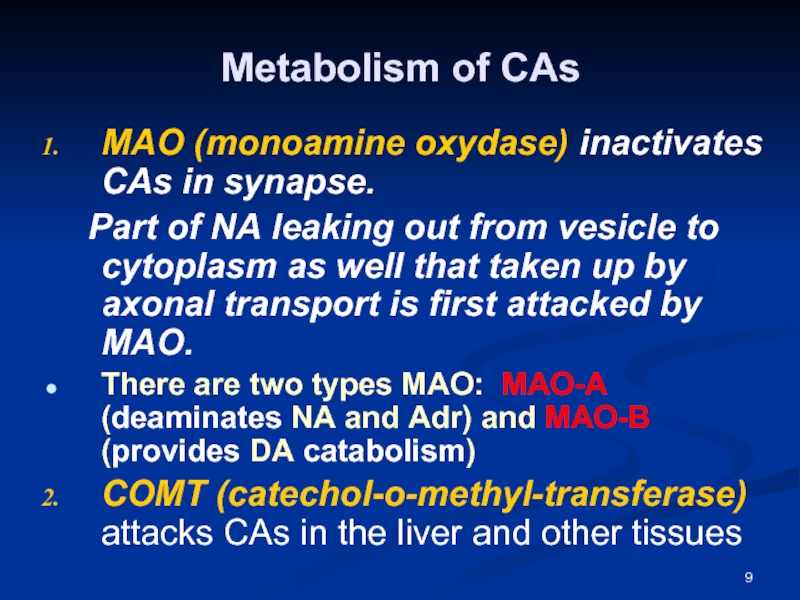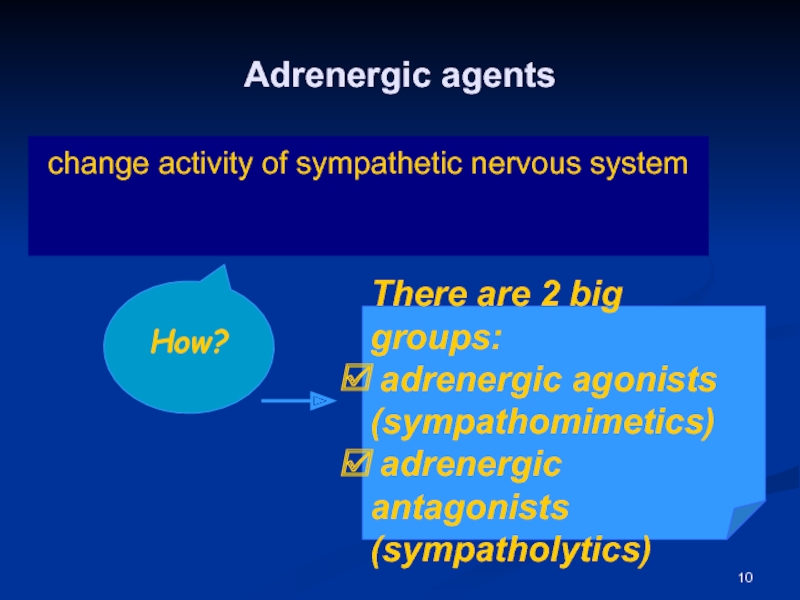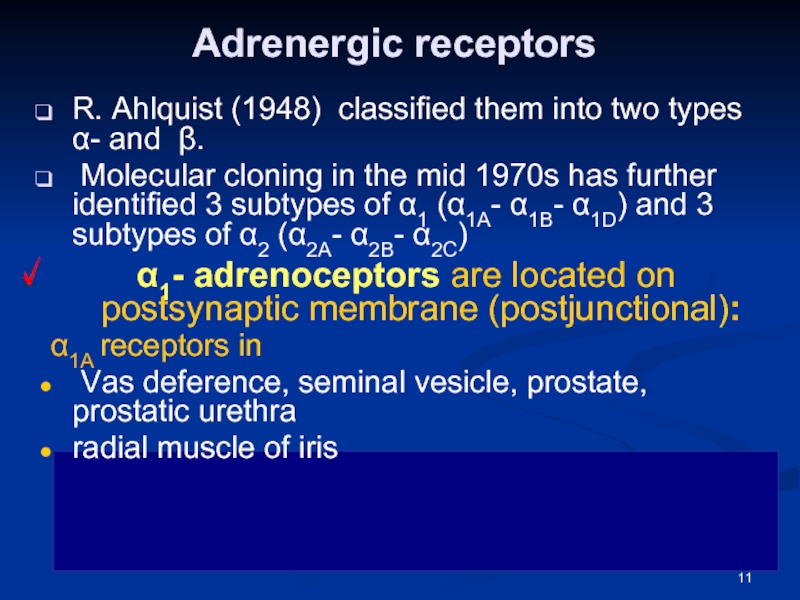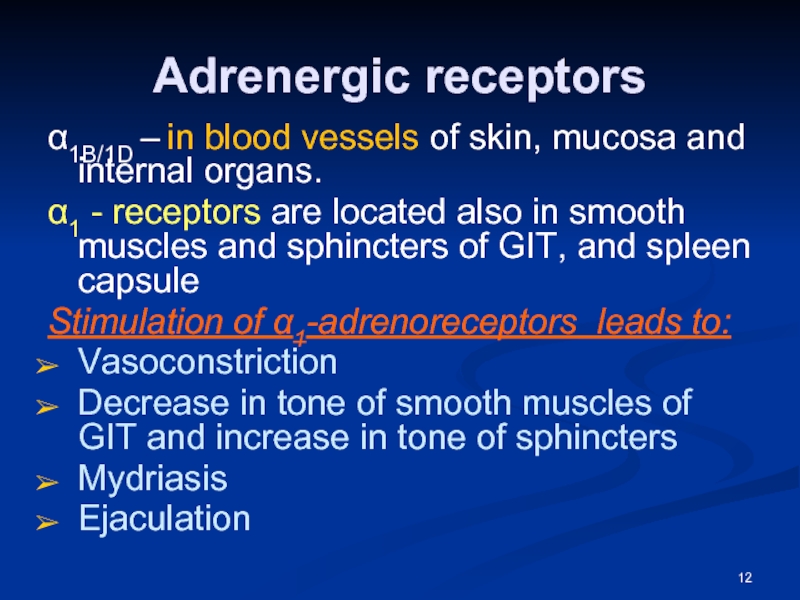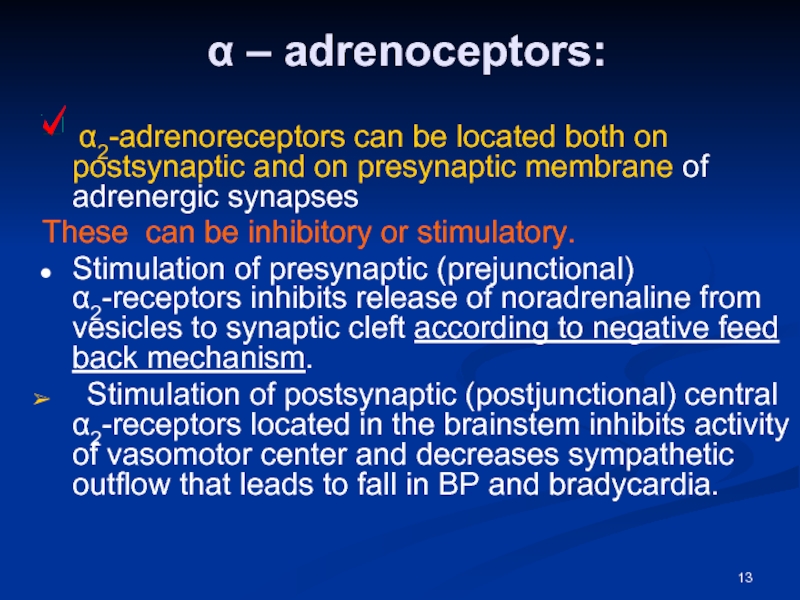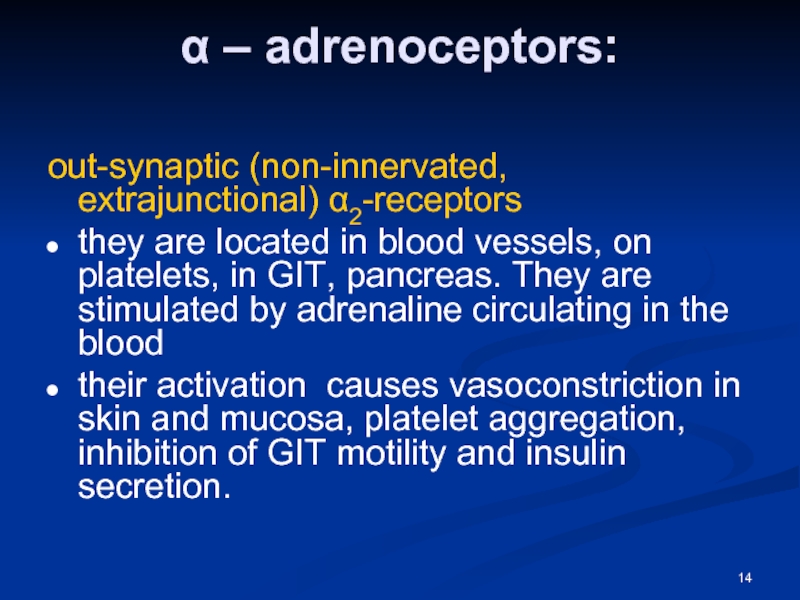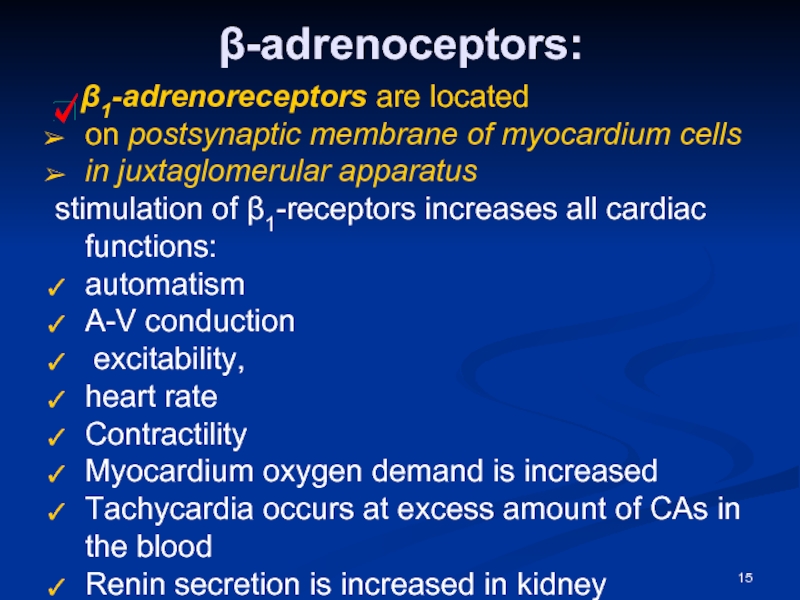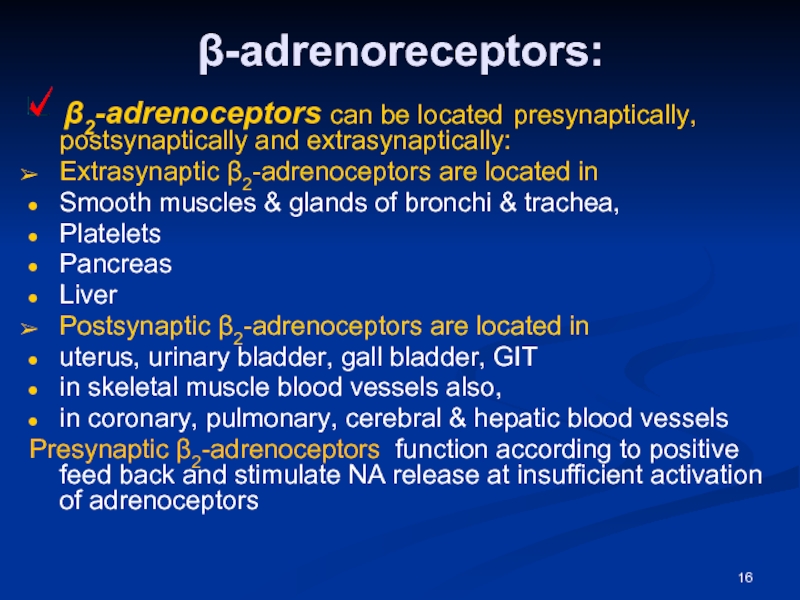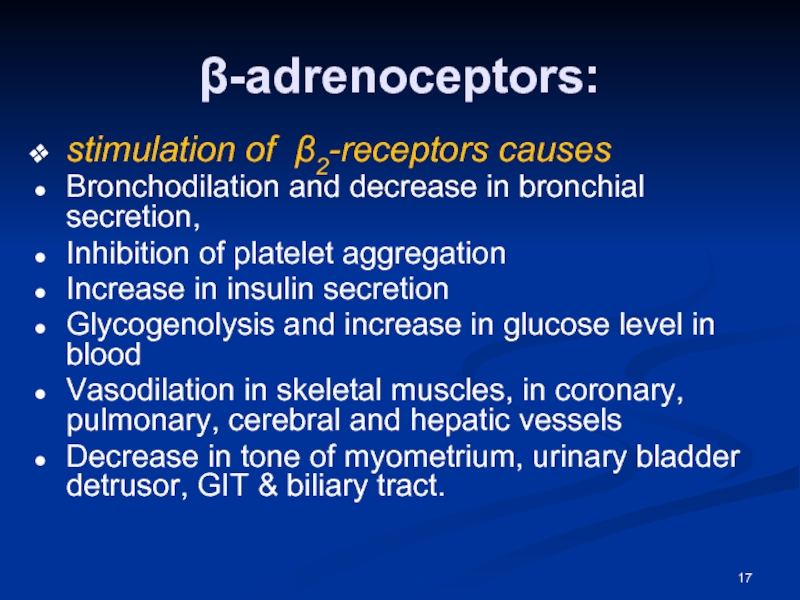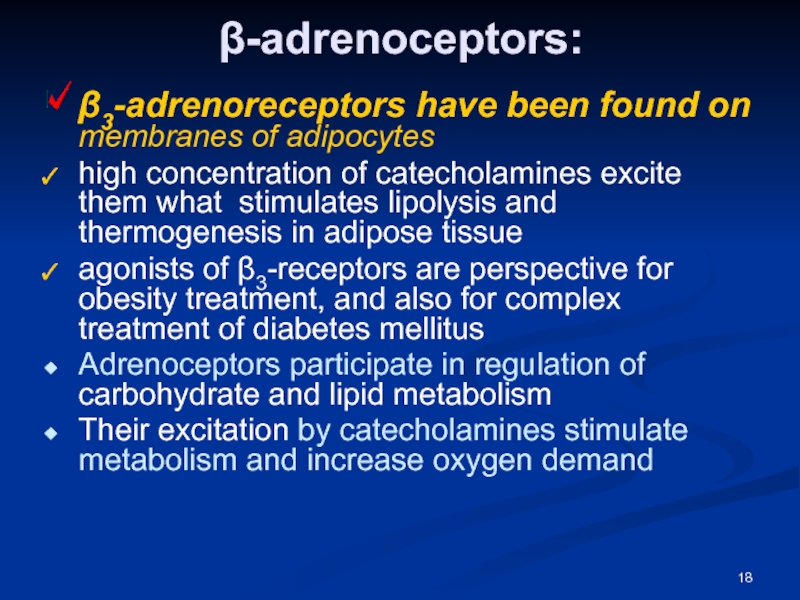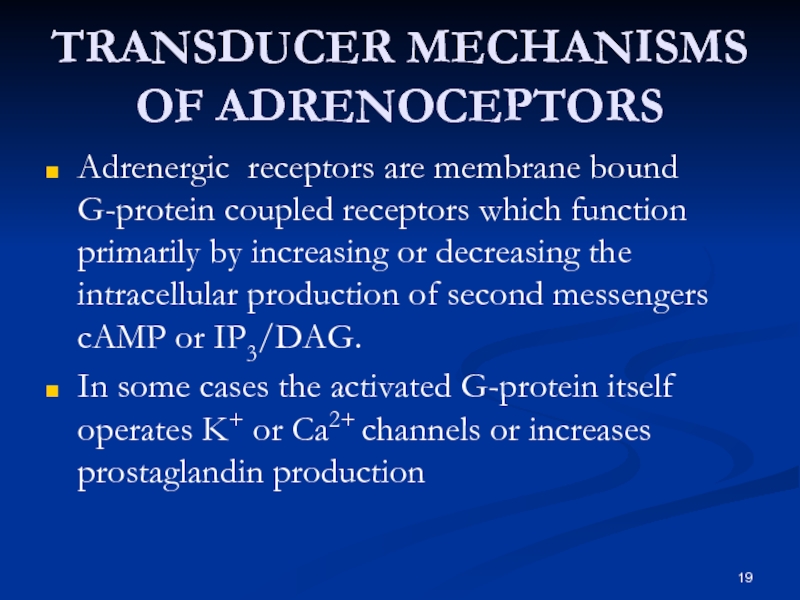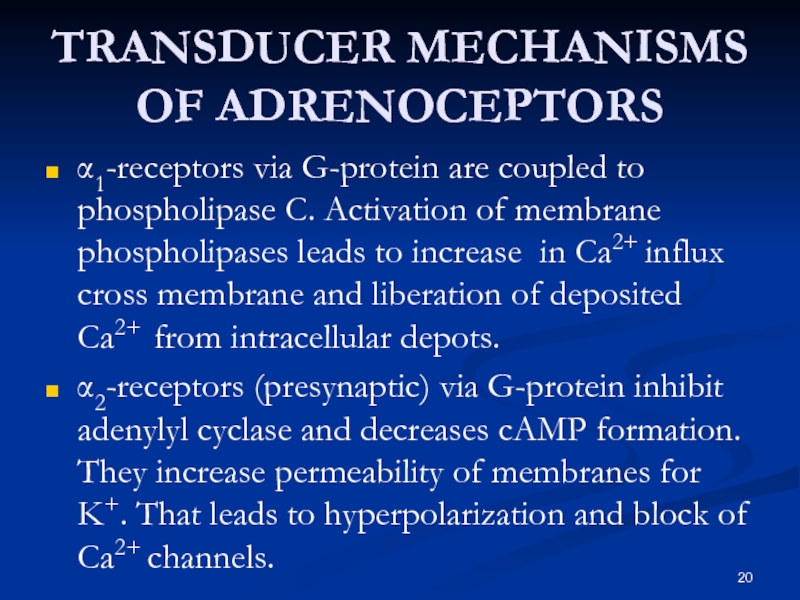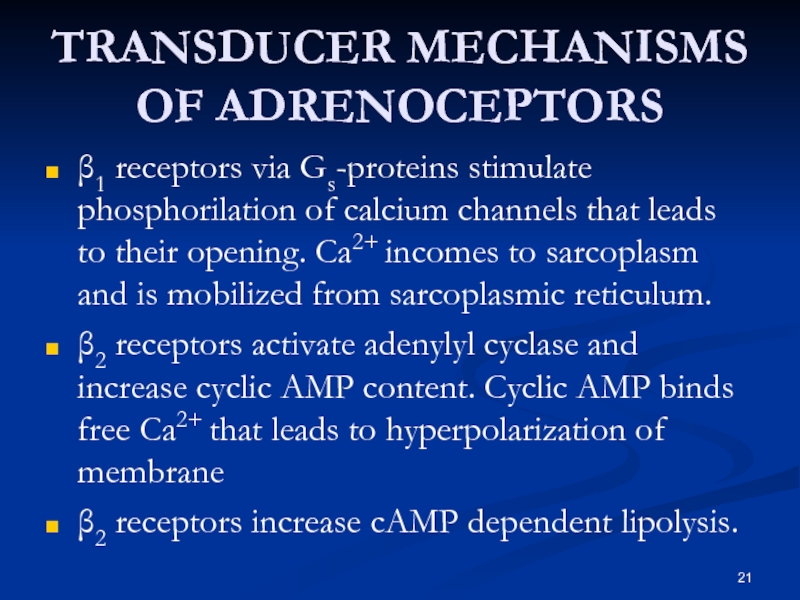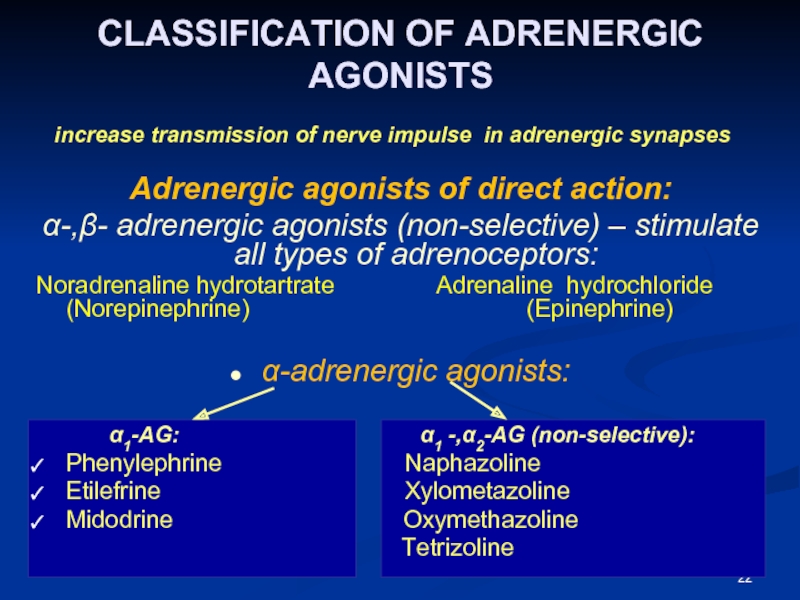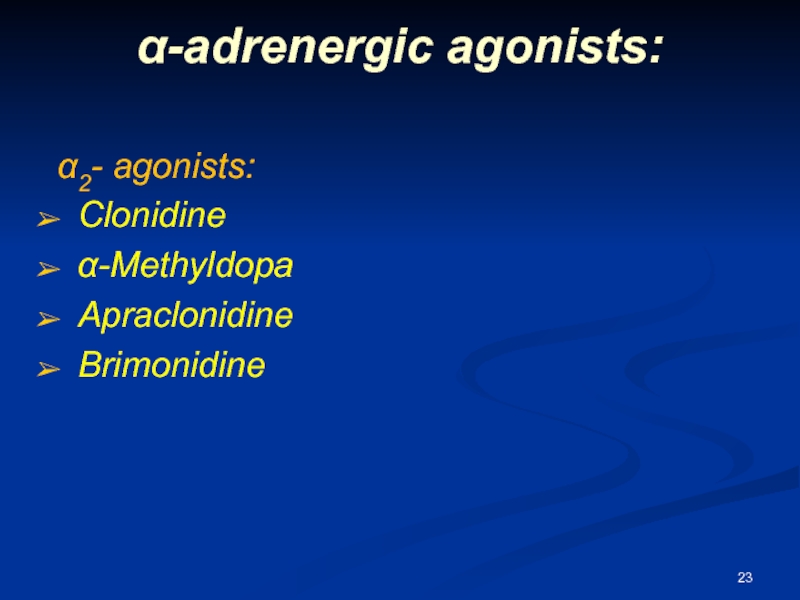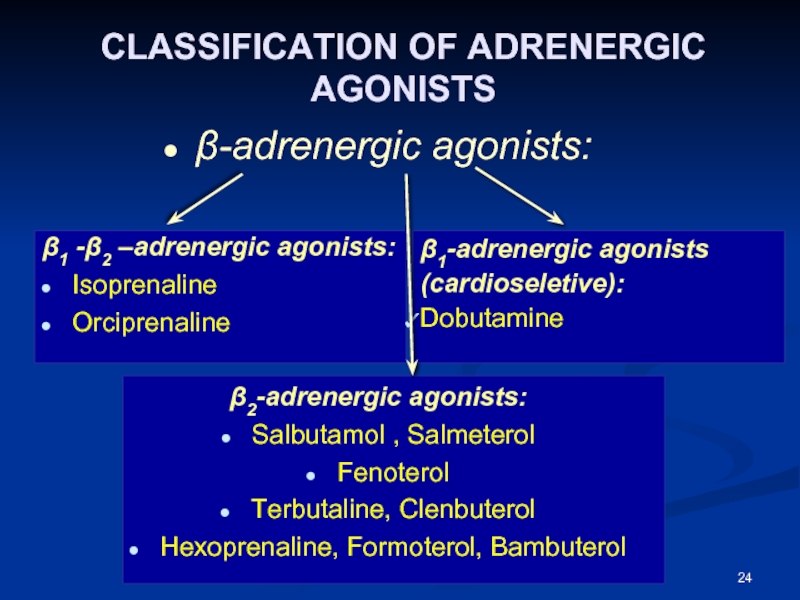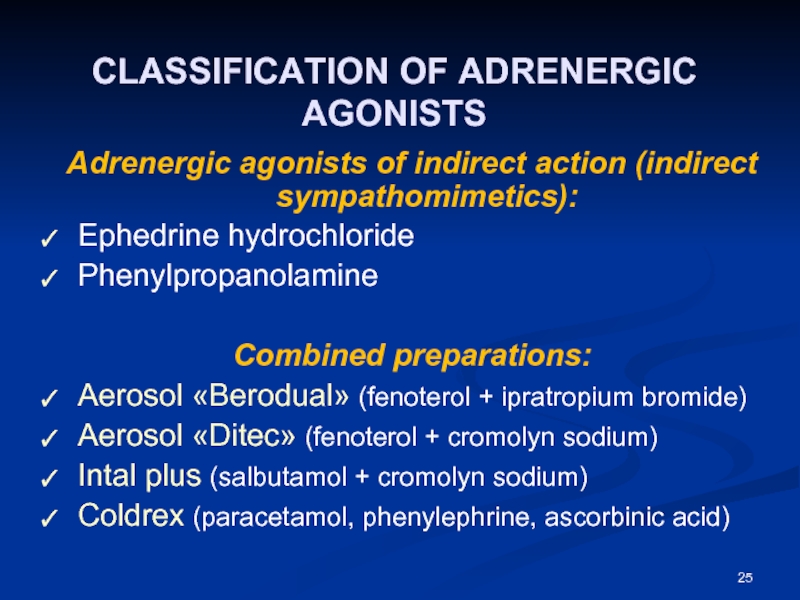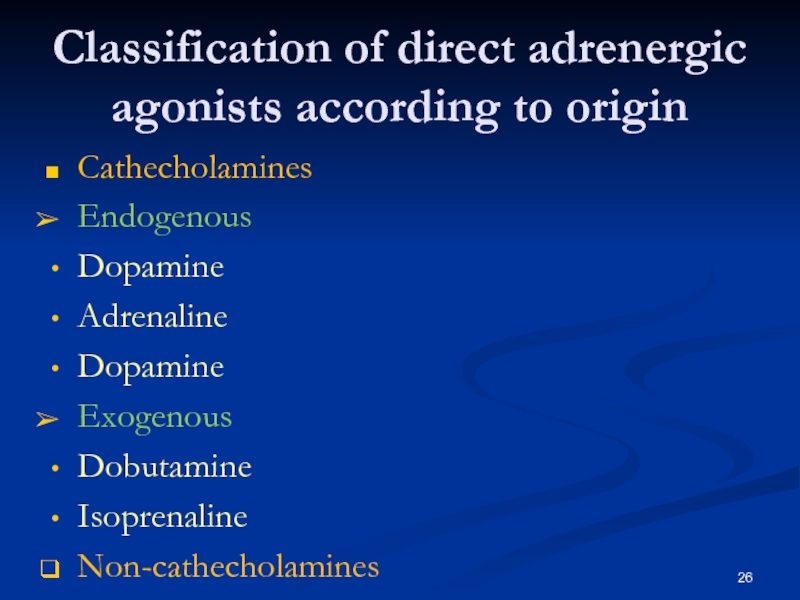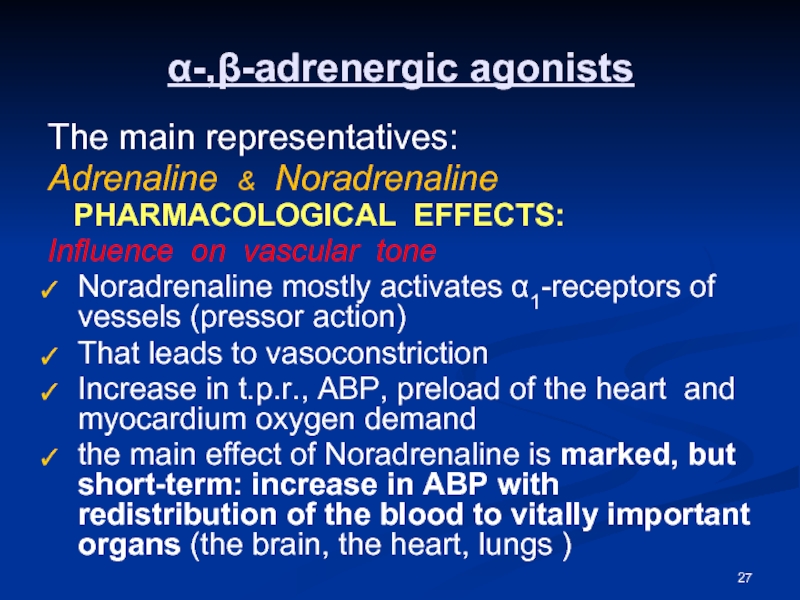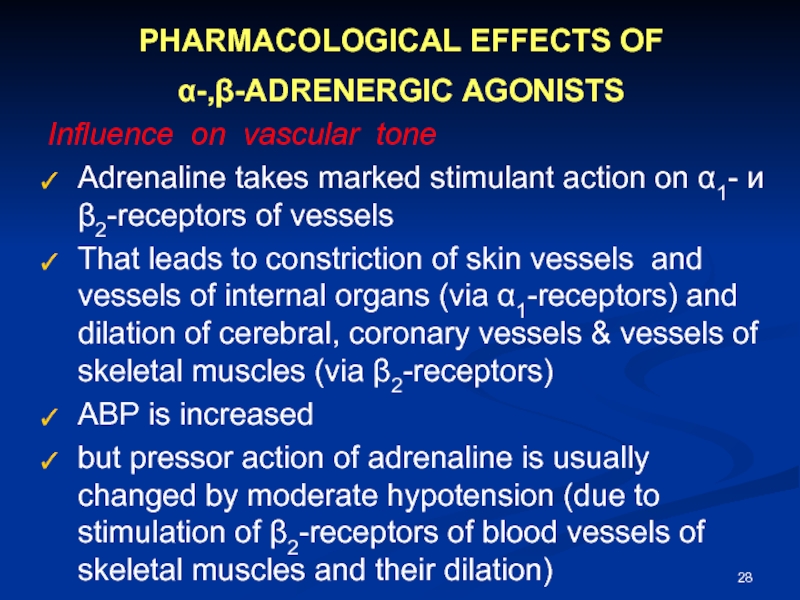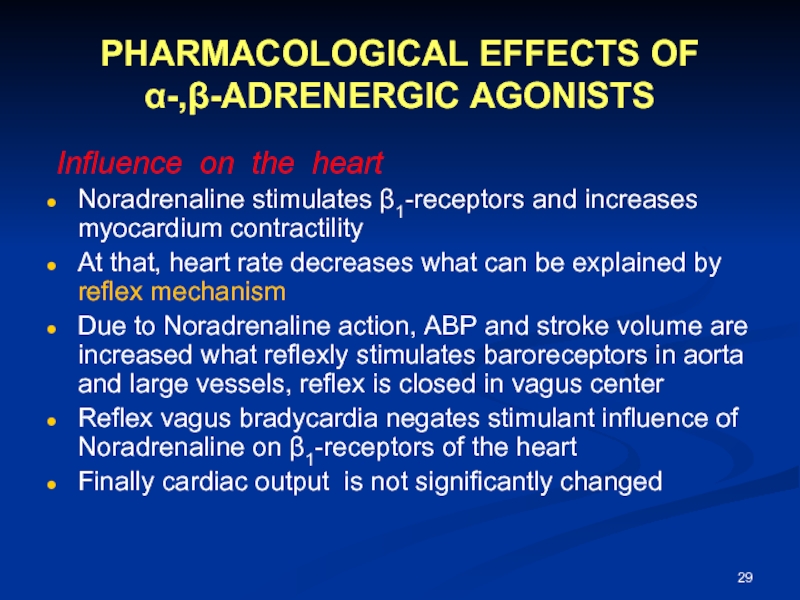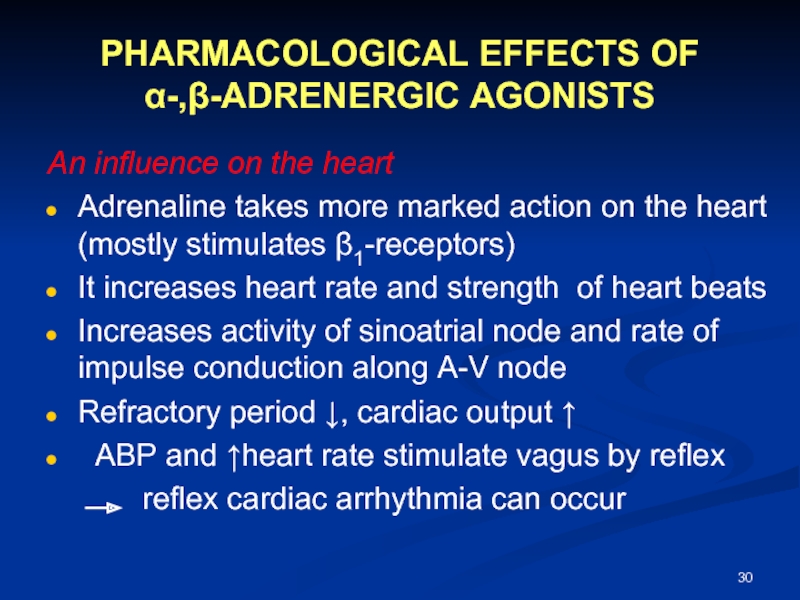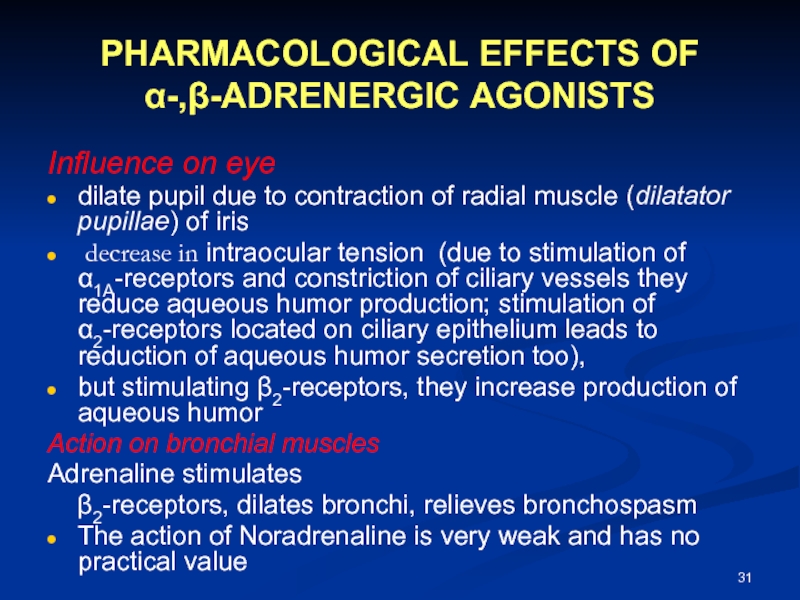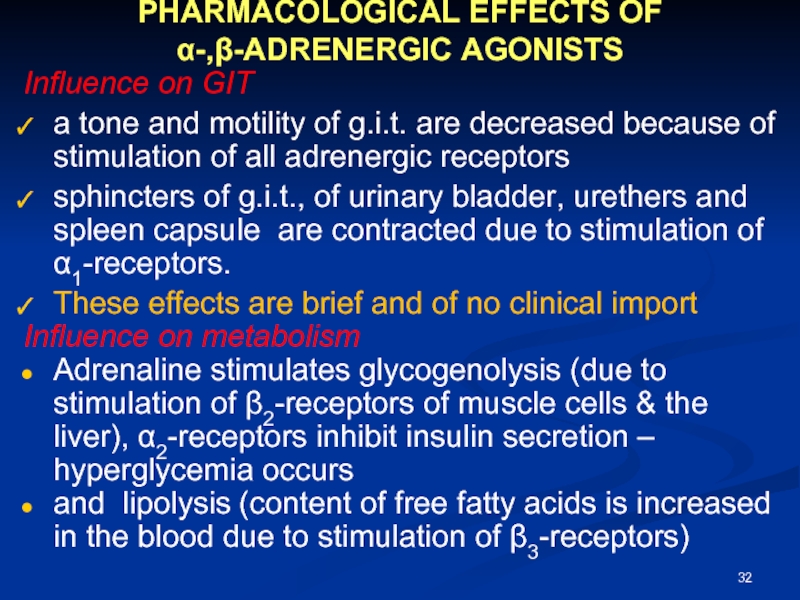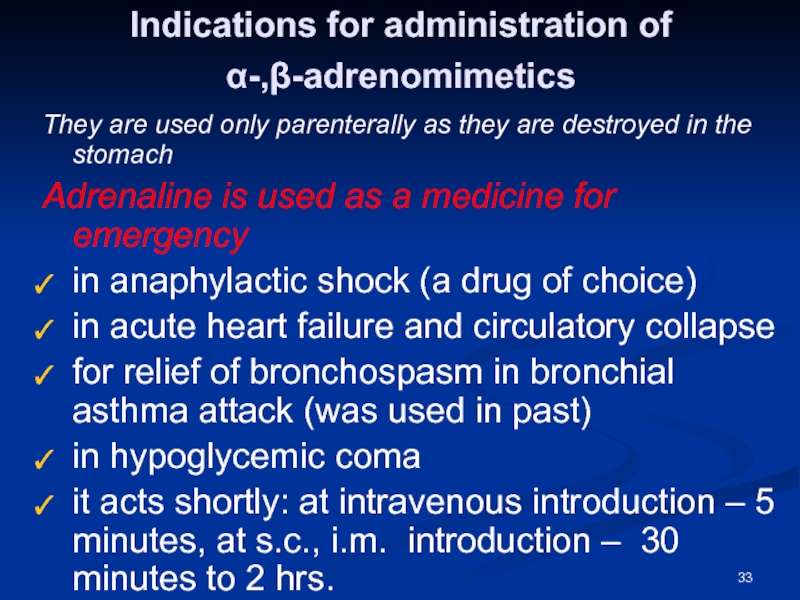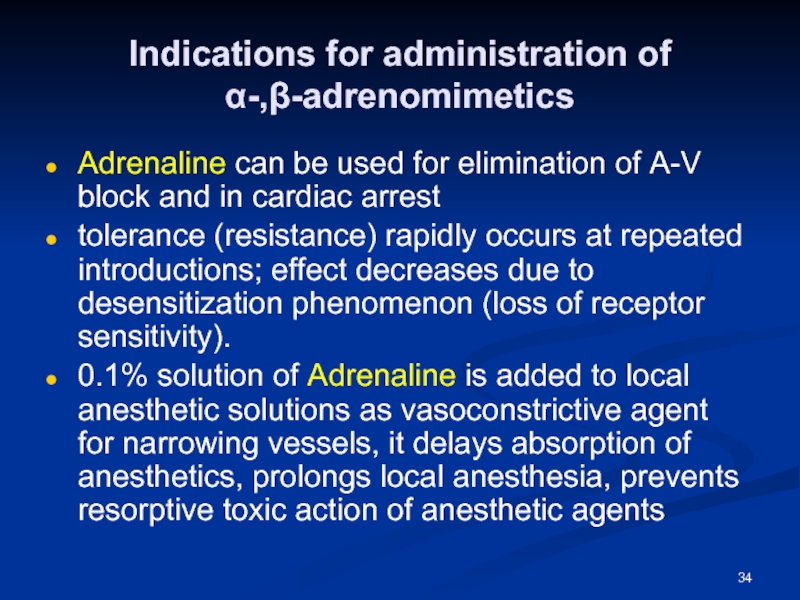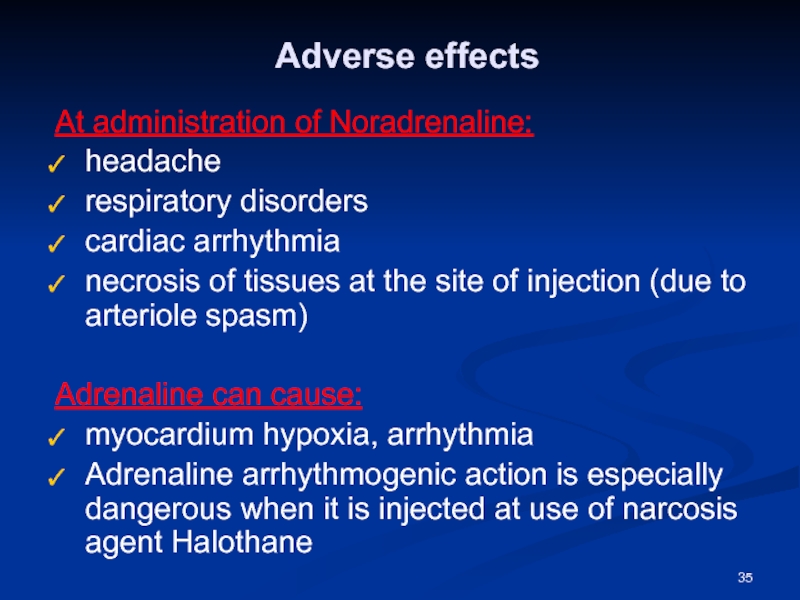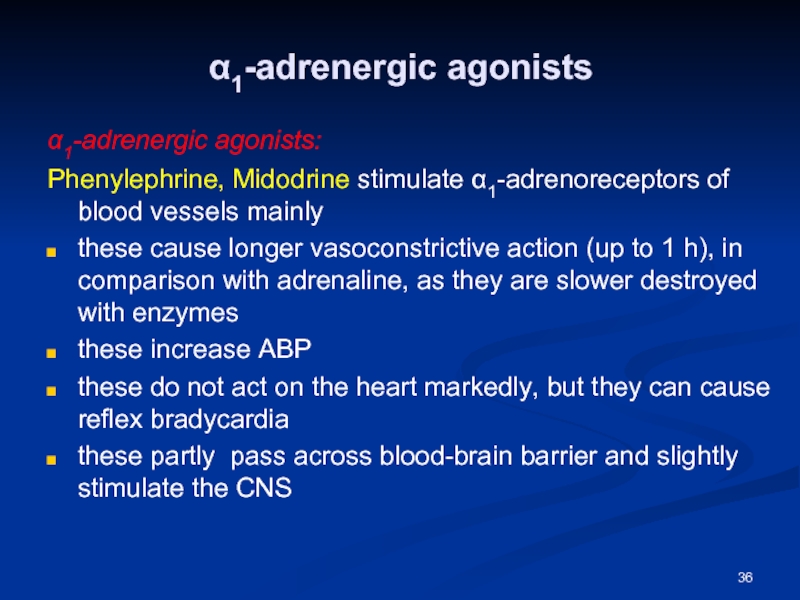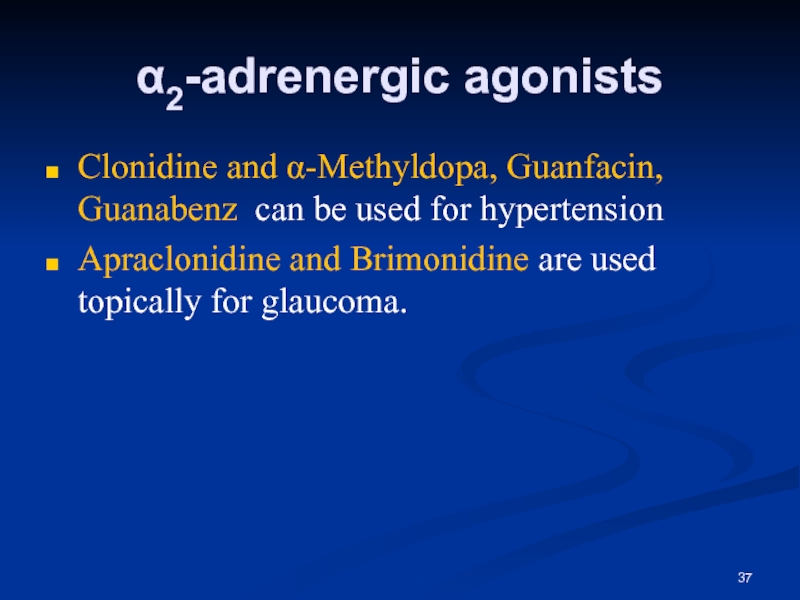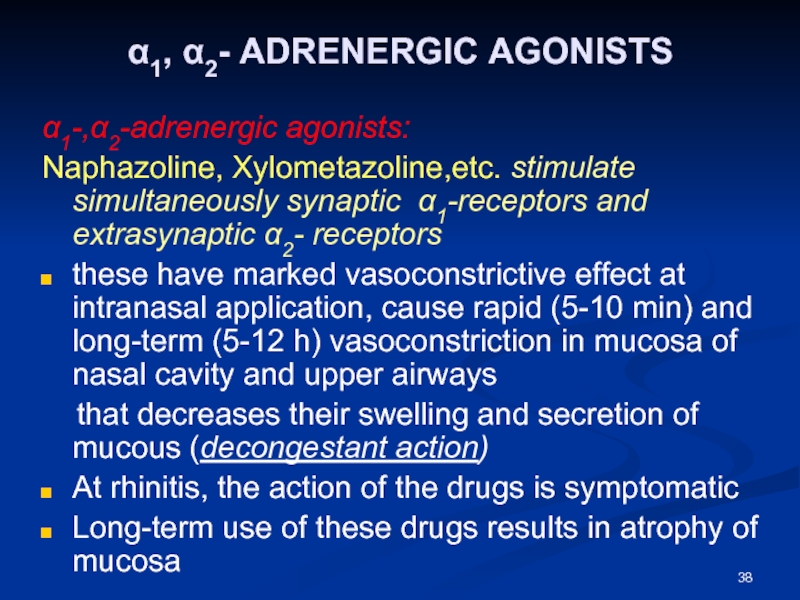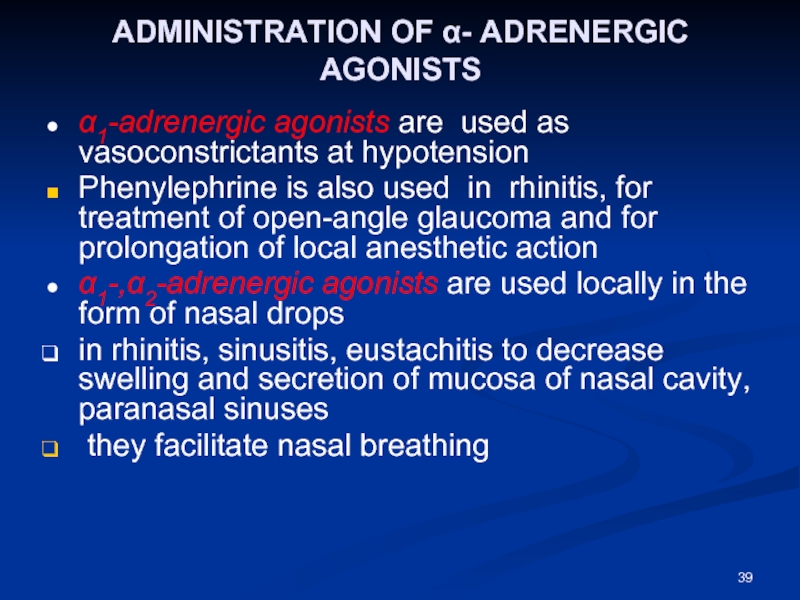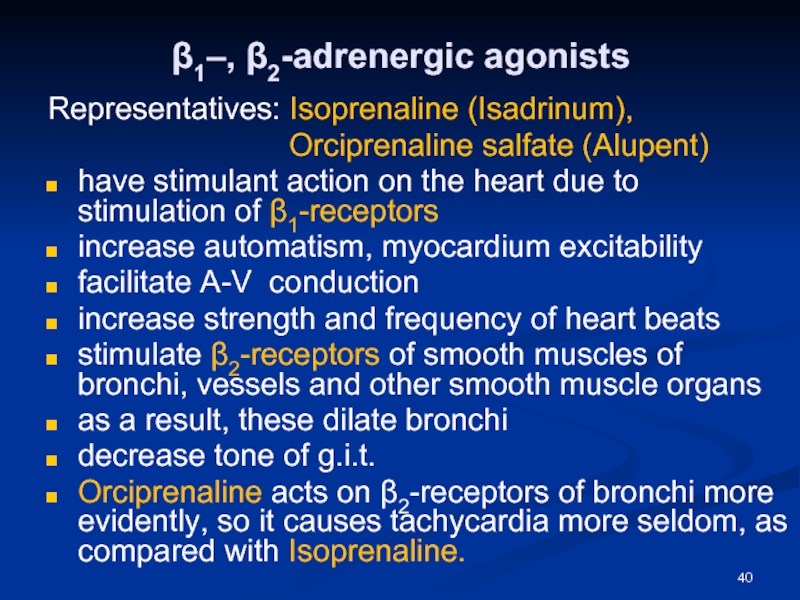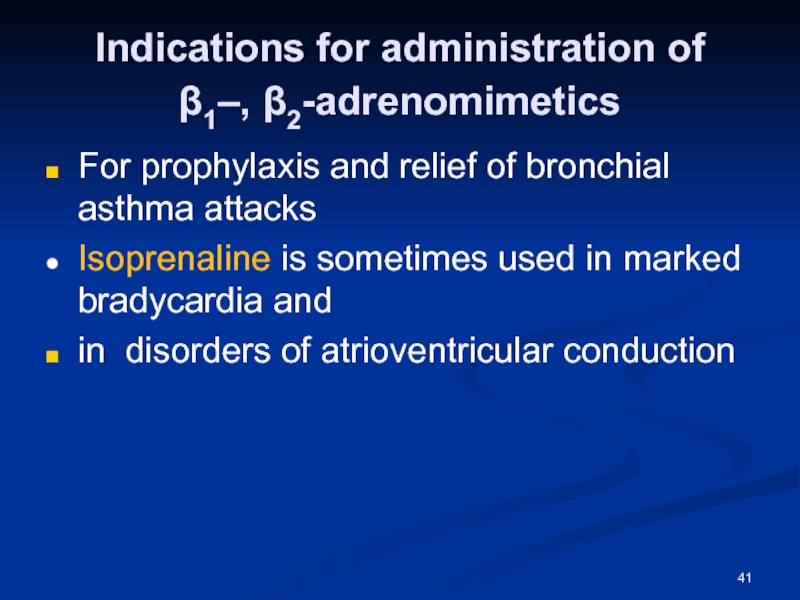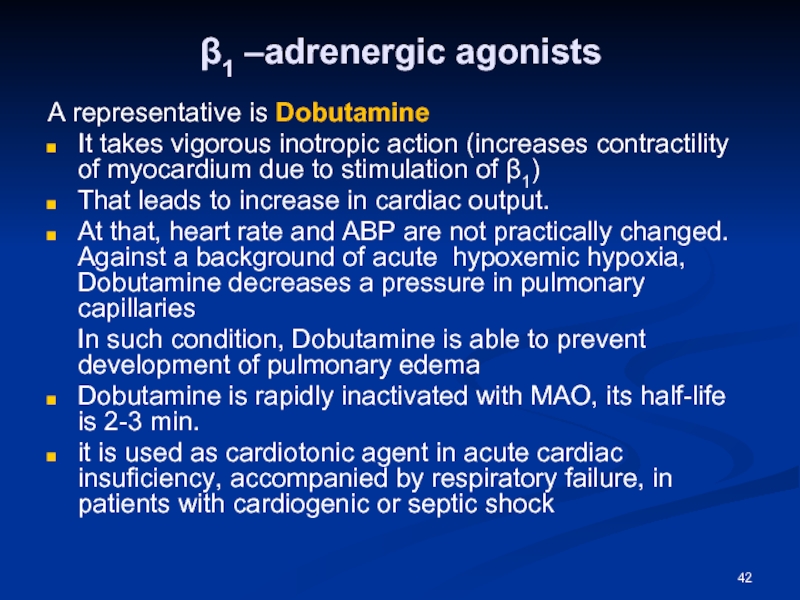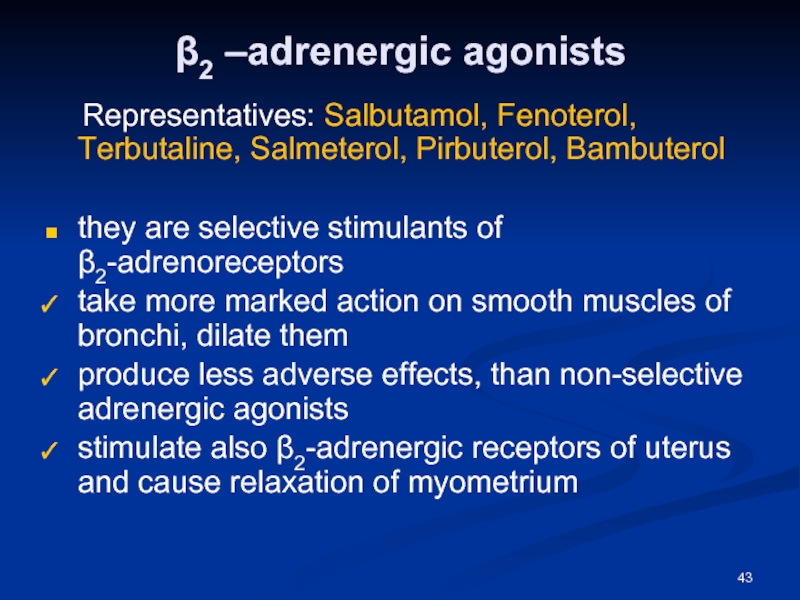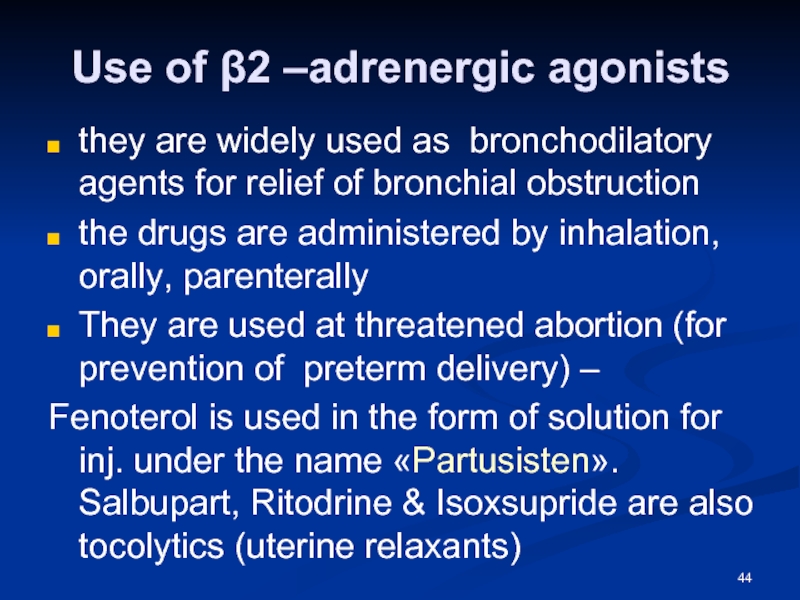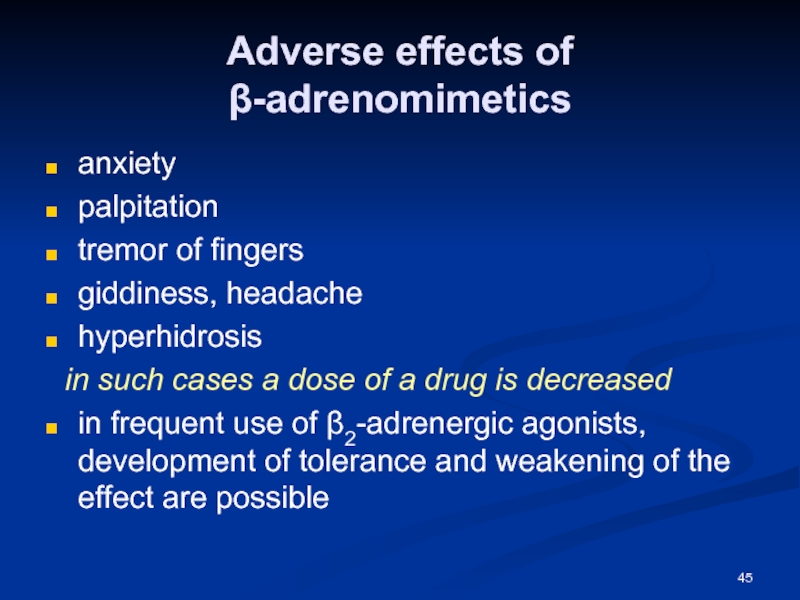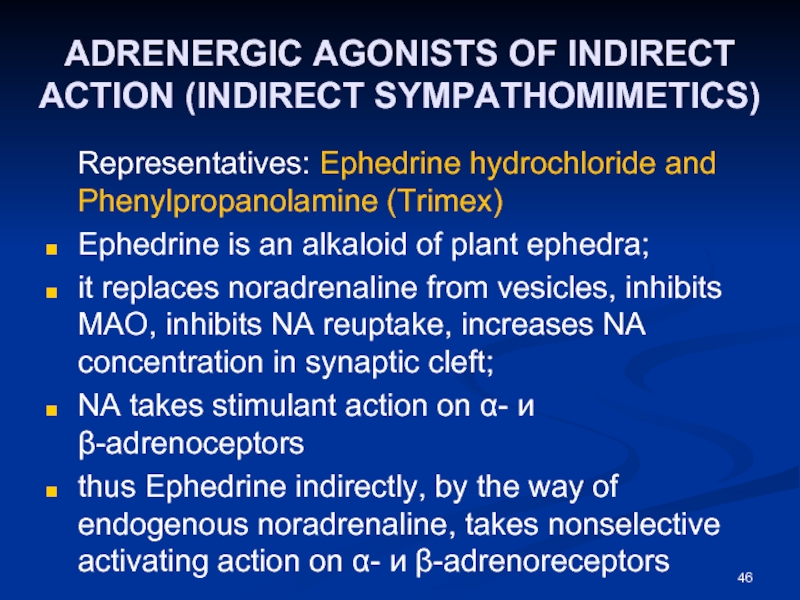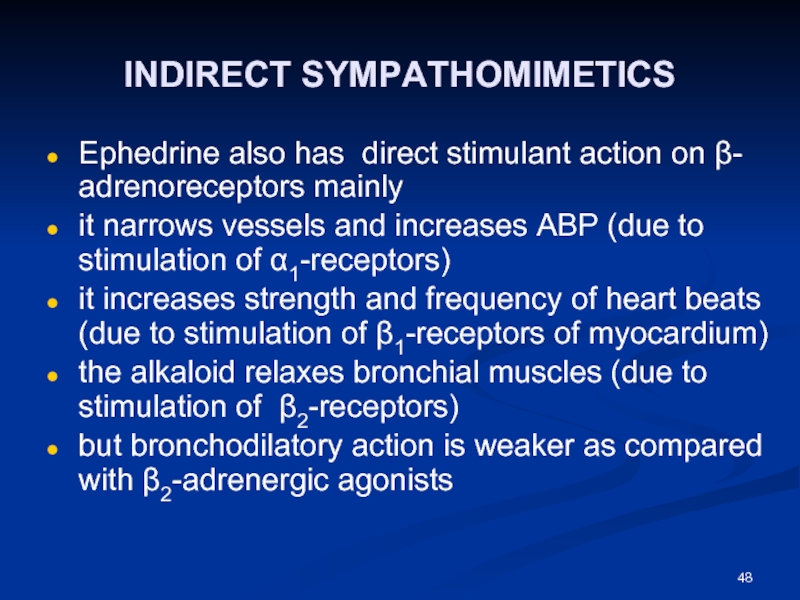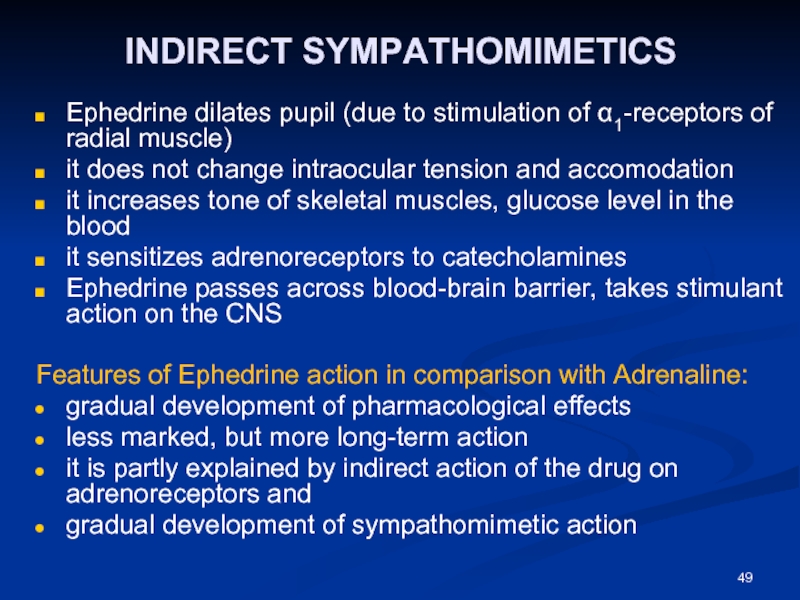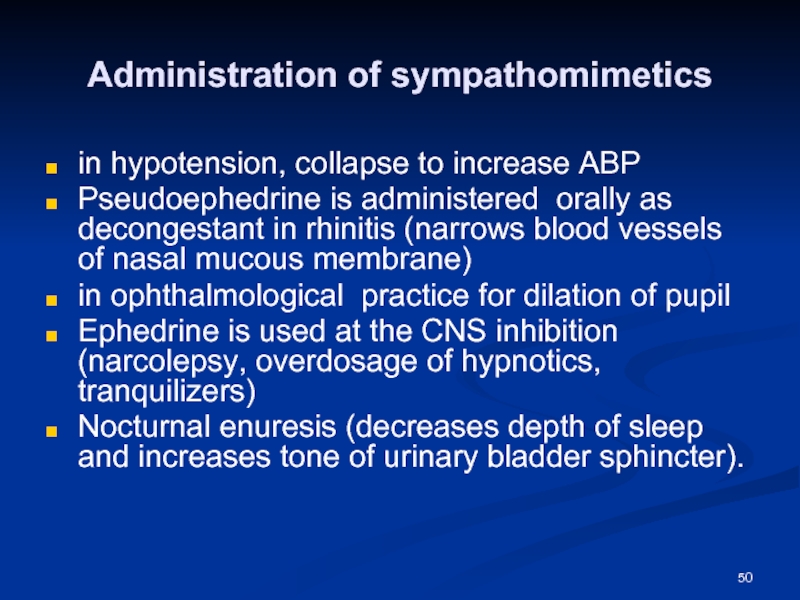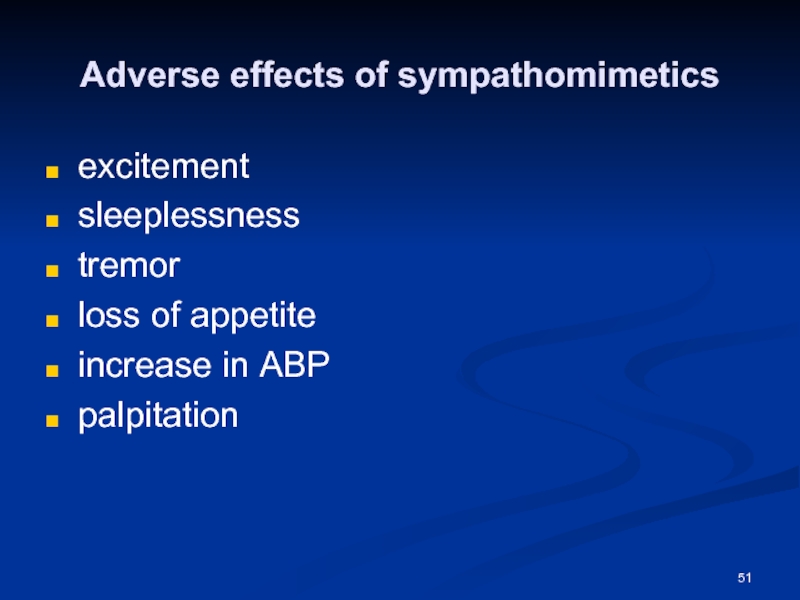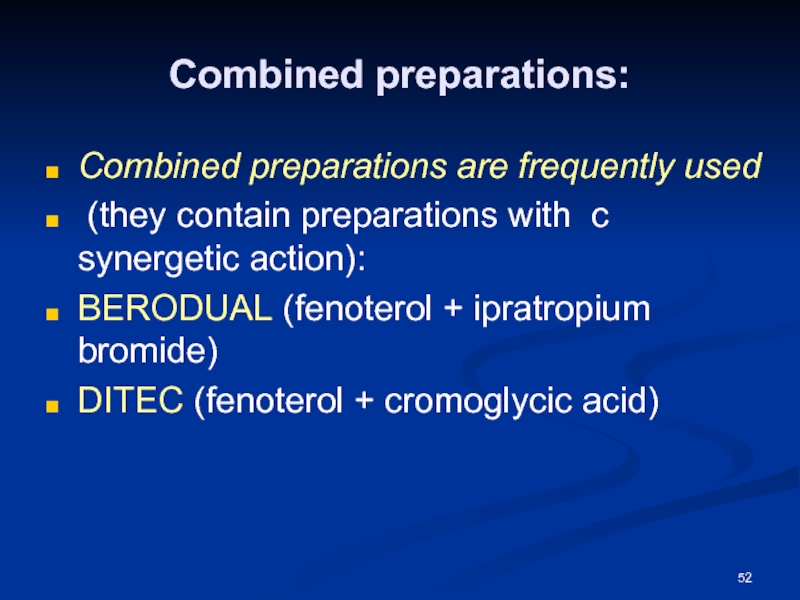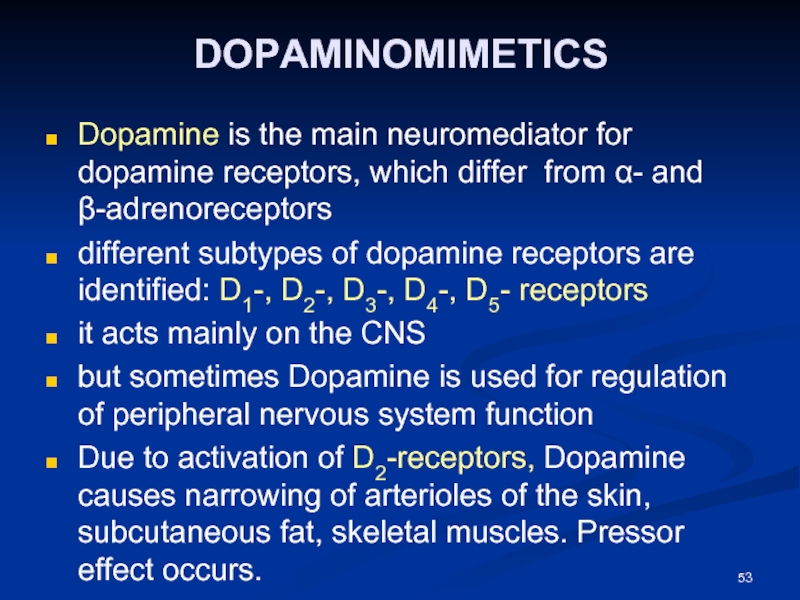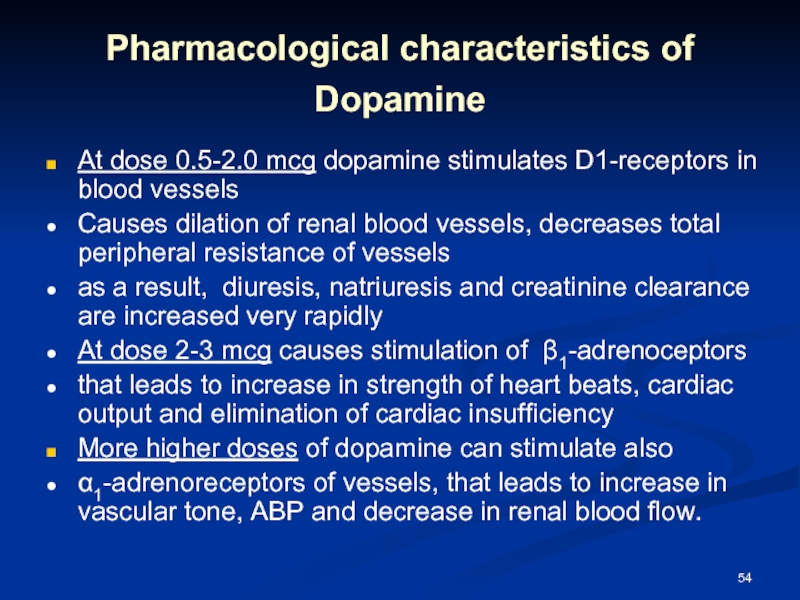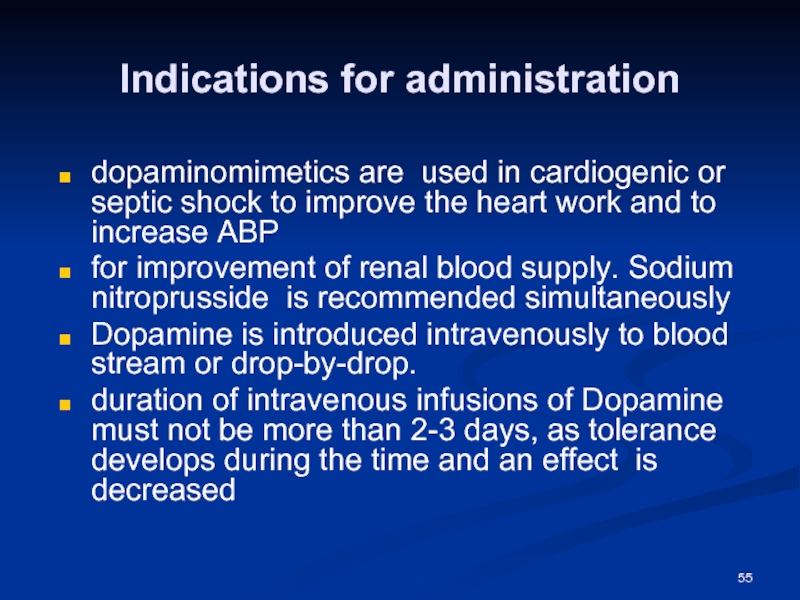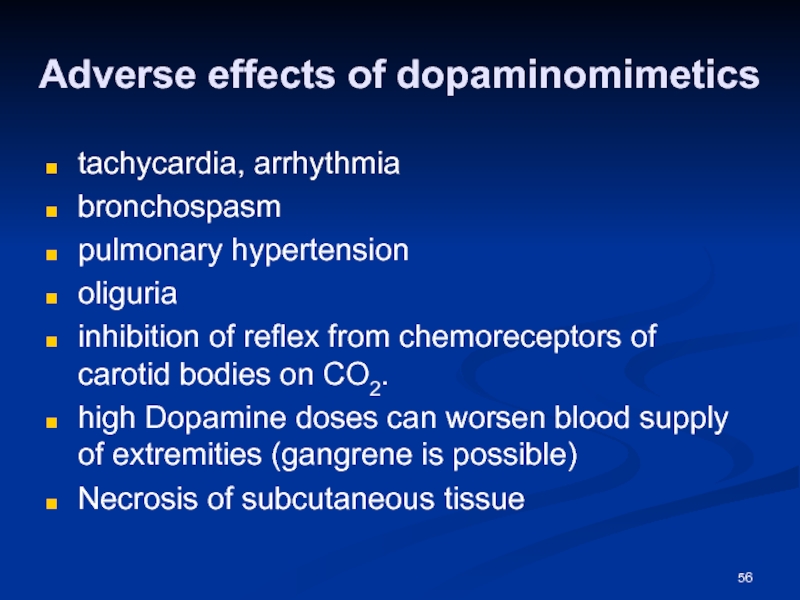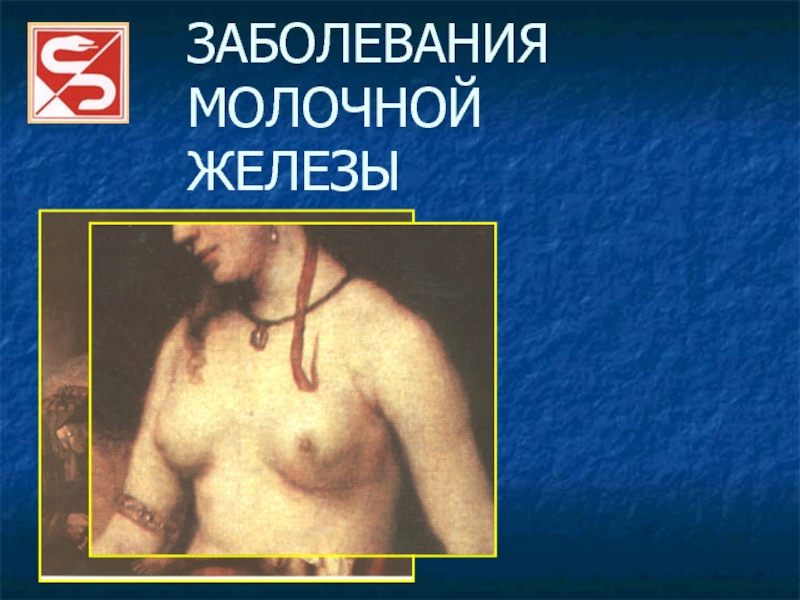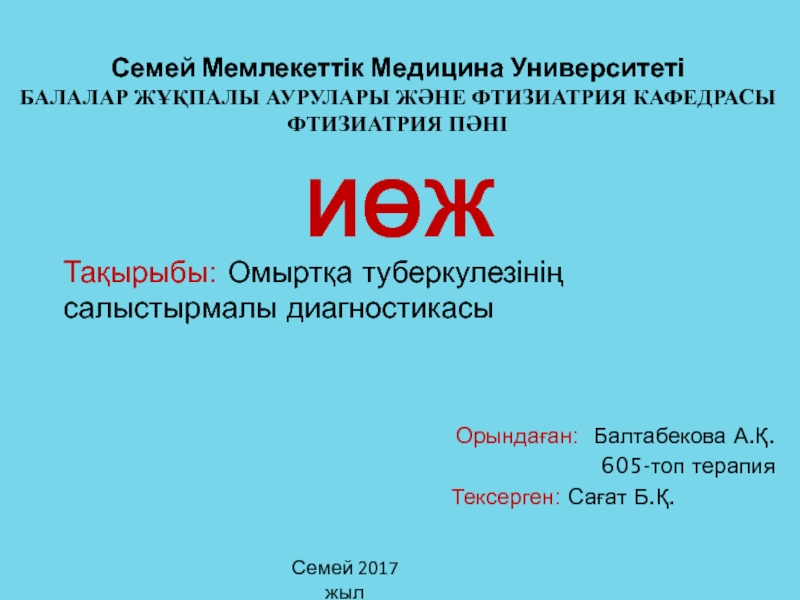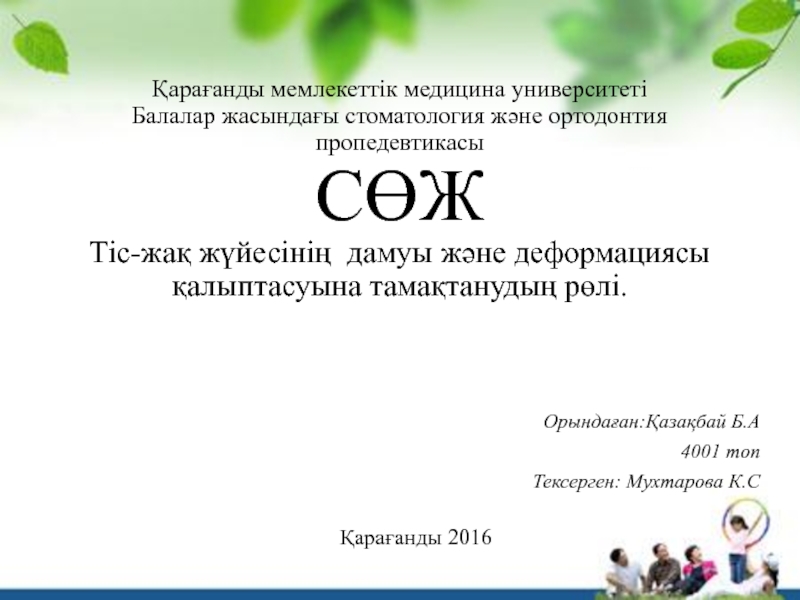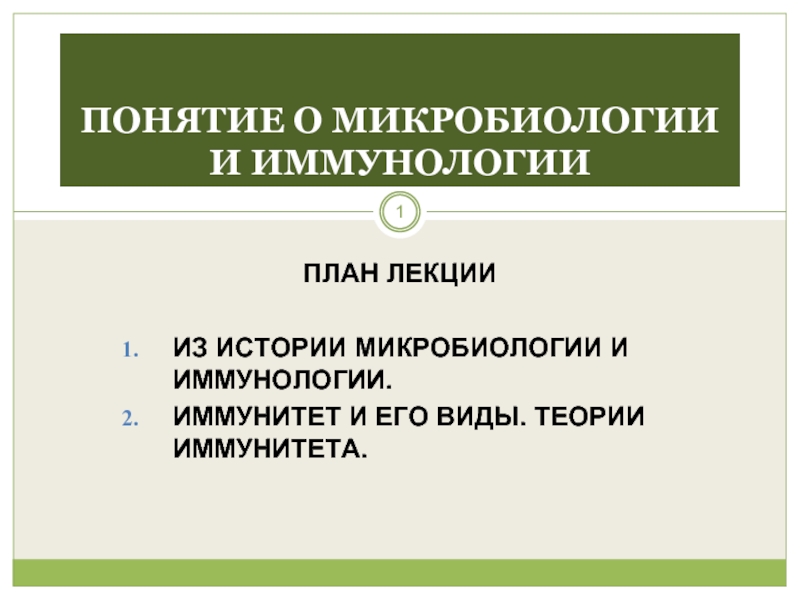- Главная
- Разное
- Дизайн
- Бизнес и предпринимательство
- Аналитика
- Образование
- Развлечения
- Красота и здоровье
- Финансы
- Государство
- Путешествия
- Спорт
- Недвижимость
- Армия
- Графика
- Культурология
- Еда и кулинария
- Лингвистика
- Английский язык
- Астрономия
- Алгебра
- Биология
- География
- Детские презентации
- Информатика
- История
- Литература
- Маркетинг
- Математика
- Медицина
- Менеджмент
- Музыка
- МХК
- Немецкий язык
- ОБЖ
- Обществознание
- Окружающий мир
- Педагогика
- Русский язык
- Технология
- Физика
- Философия
- Химия
- Шаблоны, картинки для презентаций
- Экология
- Экономика
- Юриспруденция
Adrenergic agents презентация
Содержание
- 1. Adrenergic agents
- 2. Adrenergic Synapses the main mediator of sympathetic
- 3. Adrenergic synapses Adrenergic neurones are located in
- 4. Sympathetic synapses
- 5. Adrenergic agents Noradrenaline is the main
- 6. Uptake of CAs After dissociation of complex
- 7. NET – norepinephrine transporter
- 8. Uptake of CAs Extraneuronal uptake (uptake-2) with
- 9. Metabolism of CAs МАО (monoamine oxydase) inactivates
- 10. Adrenergic agents change activity of sympathetic
- 11. Adrenergic receptors R. Ahlquist (1948)
- 12. Adrenergic receptors α1B/1D – in blood
- 13. α – adrenoceptors:
- 14. α – adrenoceptors: out-synaptic (non-innervated, extrajunctional)
- 15. β-adrenoceptors: β1-adrenoreceptors are located
- 16. β-adrenoreceptors: β2-adrenoceptors can be located
- 17. β-adrenoceptors: stimulation of β2-receptors causes Bronchodilation and
- 18. β-adrenoceptors: β3-adrenoreceptors have been
- 19. TRANSDUCER MECHANISMS OF ADRENOCEPTORS Adrenergic receptors are
- 20. TRANSDUCER MECHANISMS OF ADRENOCEPTORS α1-receptors via G-protein
- 21. TRANSDUCER MECHANISMS OF ADRENOCEPTORS β1 receptors via
- 22. CLASSIFICATION OF ADRENERGIC AGONISTS
- 23. α-adrenergic agonists: α2- agonists: Clonidine α-Methyldopa Apraclonidine Brimonidine
- 24. CLASSIFICATION OF ADRENERGIC AGONISTS β-adrenergic
- 25. CLASSIFICATION OF ADRENERGIC AGONISTS Adrenergic agonists of
- 26. Classification of direct adrenergic agonists according to
- 27. α-,β-adrenergic agonists The main representatives: Adrenaline
- 28. PHARMACOLOGICAL EFFECTS OF α-,β-ADRENERGIC AGONISTS
- 29. PHARMACOLOGICAL EFFECTS OF α-,β-ADRENERGIC AGONISTS
- 30. PHARMACOLOGICAL EFFECTS OF α-,β-ADRENERGIC AGONISTS An
- 31. PHARMACOLOGICAL EFFECTS OF α-,β-ADRENERGIC AGONISTS Influence
- 32. PHARMACOLOGICAL EFFECTS OF α-,β-ADRENERGIC AGONISTS Influence
- 33. Indications for administration of α-,β-adrenomimetics
- 34. Indications for administration of α-,β-adrenomimetics Adrenaline
- 35. Adverse effects At administration of Noradrenaline:
- 36. α1-adrenergic agonists α1-adrenergic agonists: Phenylephrine, Midodrine
- 37. α2-adrenergic agonists Clonidine and α-Methyldopa, Guanfacin, Guanabenz
- 38. α1, α2- ADRENERGIC AGONISTS α1-,α2-adrenergic agonists:
- 39. ADMINISTRATION OF α- ADRENERGIC AGONISTS α1-adrenergic agonists
- 40. β1–, β2-adrenergic agonists Representatives: Isoprenaline (Isadrinum),
- 41. Indications for administration of β1–, β2-adrenomimetics
- 42. β1 –adrenergic agonists A representative is Dobutamine
- 43. β2 –adrenergic agonists Representatives: Salbutamol,
- 44. Use of β2 –adrenergic agonists they are
- 45. Adverse effects of β-adrenomimetics anxiety palpitation
- 46. ADRENERGIC AGONISTS OF INDIRECT ACTION (INDIRECT SYMPATHOMIMETICS)
- 47. Ephedra disthachya
- 48. INDIRECT SYMPATHOMIMETICS Ephedrine also has direct stimulant
- 49. INDIRECT SYMPATHOMIMETICS Ephedrine dilates pupil (due to
- 50. Administration of sympathomimetics in hypotension, collapse to
- 51. Adverse effects of sympathomimetics excitement sleeplessness tremor
- 52. Combined preparations: Combined preparations are frequently used
- 53. DOPAMINOMIMETICS Dopamine is the main neuromediator
- 54. Pharmacological characteristics of Dopamine At dose
- 55. Indications for administration dopaminomimetics are used
- 56. Adverse effects of dopaminomimetics tachycardia, arrhythmia bronchospasm
Слайд 2Adrenergic Synapses
the main mediator of sympathetic nervous system is Nоradrenaline (Norepinephrine),
Adrenergic agents take their action on adrenergic synapses
Where are they located?
Perypheral adrenergic synapses located In postganglionic part of adrenergic nerve fiber
Слайд 3Adrenergic synapses
Adrenergic neurones are located in the CNS (locus coeruleus of
Слайд 5
Adrenergic agents
Noradrenaline is the main mediator at postganglionic sympathetic site (except
Adrenaline has a transmitter role in brain.
Dopamine is a major transmitter in basal ganglions, limbic system, CTZ, anterior pituitary, etc. and in limited manner in the periphery
SYNTHESIS OF CAs
TYROSINE DОPА Dоpаmine
Noradrenaline Adrenaline
Tyrosine
hydroxylase
hydroxylase
Dopamine-
in medulla
of adrenals
catecholamines produced from tyrosine
is secreted to the blood
interacts with adreno-R
Слайд 6Uptake of CAs
After dissociation of complex “noradrenalin-adrenoceptor”, the mediator is inactivated
Neuronal uptake which occurs in two steps
Axonal uptake (uptake-1) – active Na+ coupled transport by amine pump across presynaptic membrane
Vesicular uptake with another amine pump by exchanging with H+ ions.
Слайд 8Uptake of CAs
Extraneuronal uptake (uptake-2) with neuroglia, fibroblasts, cardiomyocytes, endothelial cells
About 80% noradrenaline undergoes neuronal reuptake
10% undergoes extraneuronal reuptake
10% undergoes enzymatic desintegration
Слайд 9Metabolism of CAs
МАО (monoamine oxydase) inactivates CAs in synapse.
Part of
There are two types MAO: МАО-А (deaminates NA and Adr) and МАО-В (provides DA catabolism)
CОМТ (catechol-о-methyl-transferase) attacks CAs in the liver and other tissues
Слайд 10
Adrenergic agents
change activity of sympathetic nervous system
How?
There are 2 big groups:
(sympathomimetics)
adrenergic antagonists (sympatholytics)
Слайд 11
Adrenergic receptors
R. Ahlquist (1948) classified them into two types α-
Molecular cloning in the mid 1970s has further identified 3 subtypes of α1 (α1A- α1B- α1D) and 3 subtypes of α2 (α2A- α2B- α2C)
α1- adrenoceptors are located on postsynaptic membrane (postjunctional):
α1A receptors in
Vas deference, seminal vesicle, prostate, prostatic urethra
radial muscle of iris
Слайд 12Adrenergic receptors
α1B/1D – in blood vessels of skin, mucosa and
α1 - receptors are located also in smooth muscles and sphincters of GIT, and spleen capsule
Stimulation of α1-adrenoreceptors leads to:
Vasoconstriction
Decrease in tone of smooth muscles of GIT and increase in tone of sphincters
Mydriasis
Ejaculation
Слайд 13α – adrenoceptors:
α2-adrenoreceptors can be located both on
These can be inhibitory or stimulatory.
Stimulation of presynaptic (prejunctional) α2-receptors inhibits release of noradrenaline from vesicles to synaptic cleft according to negative feed back mechanism.
Stimulation of postsynaptic (postjunctional) central α2-receptors located in the brainstem inhibits activity of vasomotor center and decreases sympathetic outflow that leads to fall in BP and bradycardia.
Слайд 14α – adrenoceptors:
out-synaptic (non-innervated, extrajunctional) α2-receptors
they are located in blood vessels,
their activation causes vasoconstriction in skin and mucosa, platelet aggregation, inhibition of GIT motility and insulin secretion.
Слайд 15β-adrenoceptors:
β1-adrenoreceptors are located
on postsynaptic membrane of myocardium cells
in
stimulation of β1-receptors increases all cardiac functions:
automatism
A-V conduction
excitability,
heart rate
Contractility
Myocardium oxygen demand is increased
Tachycardia occurs at excess amount of CAs in the blood
Renin secretion is increased in kidney
Слайд 16β-adrenoreceptors:
β2-adrenoceptors can be located presynaptically, postsynaptically and extrasynaptically:
Extrasynaptic
Smooth muscles & glands of bronchi & trachea,
Platelets
Pancreas
Liver
Postsynaptic β2-adrenoceptors are located in
uterus, urinary bladder, gall bladder, GIT
in skeletal muscle blood vessels also,
in coronary, pulmonary, cerebral & hepatic blood vessels
Presynaptic β2-adrenoceptors function according to positive feed back and stimulate NA release at insufficient activation of adrenoceptors
Слайд 17β-adrenoceptors:
stimulation of β2-receptors causes
Bronchodilation and decrease in bronchial secretion,
Inhibition of
Increase in insulin secretion
Glycogenolysis and increase in glucose level in blood
Vasodilation in skeletal muscles, in coronary, pulmonary, cerebral and hepatic vessels
Decrease in tone of myometrium, urinary bladder detrusor, GIT & biliary tract.
Слайд 18β-adrenoceptors:
β3-adrenoreceptors have been found on membranes of adipocytes
high concentration
agonists of β3-receptors are perspective for obesity treatment, and also for complex treatment of diabetes mellitus
Adrenoceptors participate in regulation of carbohydrate and lipid metabolism
Their excitation by catecholamines stimulate metabolism and increase oxygen demand
Слайд 19TRANSDUCER MECHANISMS OF ADRENOCEPTORS
Adrenergic receptors are membrane bound G-protein coupled receptors
In some cases the activated G-protein itself operates K+ or Ca2+ channels or increases prostaglandin production
Слайд 20TRANSDUCER MECHANISMS OF ADRENOCEPTORS
α1-receptors via G-protein are coupled to phospholipase C.
α2-receptors (presynaptic) via G-protein inhibit adenylyl cyclase and decreases cAMP formation. They increase permeability of membranes for K+. That leads to hyperpolarization and block of Ca2+ channels.
Слайд 21TRANSDUCER MECHANISMS OF ADRENOCEPTORS
β1 receptors via Gs-proteins stimulate phosphorilation of calcium
β2 receptors activate adenylyl cyclase and increase cyclic AMP content. Cyclic AMP binds free Ca2+ that leads to hyperpolarization of membrane
β2 receptors increase cAMP dependent lipolysis.
Слайд 22
CLASSIFICATION OF ADRENERGIC AGONISTS
increase transmission of nerve impulse in
Adrenergic agonists of direct action:
α-,β- adrenergic agonists (non-selective) – stimulate all types of adrenoceptors:
Noradrenaline hydrotartrate Adrenaline hydrochloride (Norepinephrine) (Epinephrine)
α-adrenergic agonists:
α1-AG: α1 -,α2-АG (non-selective):
Phenylephrine Naphazoline
Etilefrine Xylometazoline
Midodrine Oxymethazoline
Tetrizoline
Слайд 24
CLASSIFICATION OF ADRENERGIC AGONISTS
β-adrenergic agonists:
β1 -β2 –adrenergic agonists:
Isoprenaline
Orciprenaline
β2-adrenergic
Salbutamol , Salmeterol
Fenoterol
Terbutaline, Clenbuterol
Hexoprenaline, Formoterol, Bambuterol
β1-adrenergic agonists
(cardioseletive):
Dobutamine
Слайд 25CLASSIFICATION OF ADRENERGIC AGONISTS
Adrenergic agonists of indirect action (indirect sympathomimetics):
Ephedrine hydrochloride
Phenylpropanolamine
Combined
Aerosol «Berodual» (fenoterol + ipratropium bromide)
Aerosol «Ditec» (fenoterol + cromolyn sodium)
Intal plus (salbutamol + cromolyn sodium)
Coldrex (paracetamol, phenylephrine, ascorbinic acid)
Слайд 26Classification of direct adrenergic agonists according to origin
Cathecholamines
Endogenous
Dopamine
Adrenaline
Dopamine
Exogenous
Dobutamine
Isoprenaline
Non-cathecholamines
Слайд 27α-,β-adrenergic agonists
The main representatives:
Adrenaline & Noradrenaline
PHARMACOLOGICAL EFFECTS:
Influence on
Noradrenaline mostly activates α1-receptors of vessels (pressor action)
That leads to vasoconstriction
Increase in t.p.r., ABP, preload of the heart and myocardium oxygen demand
the main effect of Noradrenaline is marked, but short-term: increase in ABP with redistribution of the blood to vitally important organs (the brain, the heart, lungs )
Слайд 28PHARMACOLOGICAL EFFECTS OF
α-,β-ADRENERGIC AGONISTS
Influence on vascular tone
Adrenaline takes
That leads to constriction of skin vessels and vessels of internal organs (via α1-receptors) and dilation of cerebral, coronary vessels & vessels of skeletal muscles (via β2-receptors)
ABP is increased
but pressor action of adrenaline is usually changed by moderate hypotension (due to stimulation of β2-receptors of blood vessels of skeletal muscles and their dilation)
Слайд 29PHARMACOLOGICAL EFFECTS OF
α-,β-ADRENERGIC AGONISTS
Influence on the heart
Noradrenaline stimulates
At that, heart rate decreases what can be explained by reflex mechanism
Due to Noradrenaline action, ABP and stroke volume are increased what reflexly stimulates baroreceptors in aorta and large vessels, reflex is closed in vagus center
Reflex vagus bradycardia negates stimulant influence of Noradrenaline on β1-receptors of the heart
Finally cardiac output is not significantly changed
Слайд 30PHARMACOLOGICAL EFFECTS OF
α-,β-ADRENERGIC AGONISTS
An influence on the heart
Adrenaline takes
It increases heart rate and strength of heart beats
Increases activity of sinoatrial node and rate of impulse conduction along A-V node
Refractory period ↓, cardiac output ↑
ABP and ↑heart rate stimulate vagus by reflex
reflex cardiac arrhythmia can occur
Слайд 31PHARMACOLOGICAL EFFECTS OF
α-,β-ADRENERGIC AGONISTS
Influence on eye
dilate pupil due to
decrease in intraocular tension (due to stimulation of α1A-receptors and constriction of ciliary vessels they reduce aqueous humor production; stimulation of α2-receptors located on ciliary epithelium leads to reduction of aqueous humor secretion too),
but stimulating β2-receptors, they increase production of aqueous humor
Action on bronchial muscles
Adrenaline stimulates
β2-receptors, dilates bronchi, relieves bronchospasm
The action of Noradrenaline is very weak and has no practical value
Слайд 32PHARMACOLOGICAL EFFECTS OF
α-,β-ADRENERGIC AGONISTS
Influence on GIT
a tone and motility of
sphincters of g.i.t., of urinary bladder, urethers and spleen capsule are contracted due to stimulation of α1-receptors.
These effects are brief and of no clinical import
Influence on metabolism
Adrenaline stimulates glycogenolysis (due to stimulation of β2-receptors of muscle cells & the liver), α2-receptors inhibit insulin secretion – hyperglycemia occurs
and lipolysis (content of free fatty acids is increased in the blood due to stimulation of β3-receptors)
Слайд 33Indications for administration of
α-,β-adrenomimetics
They are used only parenterally as
Adrenaline is used as a medicine for emergency
in anaphylactic shock (a drug of choice)
in acute heart failure and circulatory collapse
for relief of bronchospasm in bronchial asthma attack (was used in past)
in hypoglycemic coma
it acts shortly: at intravenous introduction – 5 minutes, at s.c., i.m. introduction – 30 minutes to 2 hrs.
Слайд 34Indications for administration of
α-,β-adrenomimetics
Adrenaline can be used for elimination of
tolerance (resistance) rapidly occurs at repeated introductions; effect decreases due to desensitization phenomenon (loss of receptor sensitivity).
0.1% solution of Adrenaline is added to local anesthetic solutions as vasoconstrictive agent for narrowing vessels, it delays absorption of anesthetics, prolongs local anesthesia, prevents resorptive toxic action of anesthetic agents
Слайд 35Adverse effects
At administration of Noradrenaline:
headache
respiratory disorders
cardiac arrhythmia
necrosis of tissues at
Adrenaline can cause:
myocardium hypoxia, arrhythmia
Adrenaline arrhythmogenic action is especially dangerous when it is injected at use of narcosis agent Halothane
Слайд 36α1-adrenergic agonists
α1-adrenergic agonists:
Phenylephrine, Midodrine stimulate α1-adrenoreceptors of blood vessels mainly
these
these increase ABP
these do not act on the heart markedly, but they can cause reflex bradycardia
these partly pass across blood-brain barrier and slightly stimulate the CNS
Слайд 37α2-adrenergic agonists
Clonidine and α-Methyldopa, Guanfacin, Guanabenz can be used for hypertension
Apraclonidine and Brimonidine are used topically for glaucoma.
Слайд 38α1, α2- ADRENERGIC AGONISTS
α1-,α2-adrenergic agonists:
Naphazoline, Xylometazoline,etc. stimulate simultaneously synaptic α1-receptors
these have marked vasoconstrictive effect at intranasal application, cause rapid (5-10 min) and long-term (5-12 h) vasoconstriction in mucosa of nasal cavity and upper airways
that decreases their swelling and secretion of mucous (decongestant action)
At rhinitis, the action of the drugs is symptomatic
Long-term use of these drugs results in atrophy of mucosa
Слайд 39ADMINISTRATION OF α- ADRENERGIC AGONISTS
α1-adrenergic agonists are used as vasoconstrictants at
Phenylephrine is also used in rhinitis, for treatment of open-angle glaucoma and for prolongation of local anesthetic action
α1-,α2-adrenergic agonists are used locally in the form of nasal drops
in rhinitis, sinusitis, eustachitis to decrease swelling and secretion of mucosa of nasal cavity, paranasal sinuses
they facilitate nasal breathing
Слайд 40β1–, β2-adrenergic agonists
Representatives: Isoprenaline (Isadrinum),
have stimulant action on the heart due to stimulation of β1-receptors
increase automatism, myocardium excitability
facilitate А-V conduction
increase strength and frequency of heart beats
stimulate β2-receptors of smooth muscles of bronchi, vessels and other smooth muscle organs
as a result, these dilate bronchi
decrease tone of g.i.t.
Orciprenaline acts on β2-receptors of bronchi more evidently, so it causes tachycardia more seldom, as compared with Isoprenaline.
Слайд 41Indications for administration of
β1–, β2-adrenomimetics
For prophylaxis and relief of
Isoprenaline is sometimes used in marked bradycardia and
in disorders of atrioventricular conduction
Слайд 42β1 –adrenergic agonists
A representative is Dobutamine
It takes vigorous inotropic action
That leads to increase in cardiac output.
At that, heart rate and ABP are not practically changed. Against a background of acute hypoxemic hypoxia, Dobutamine decreases a pressure in pulmonary capillaries
In such condition, Dobutamine is able to prevent development of pulmonary edema
Dobutamine is rapidly inactivated with MAO, its half-life is 2-3 min.
it is used as cardiotonic agent in acute cardiac insuficiency, accompanied by respiratory failure, in patients with cardiogenic or septic shock
Слайд 43β2 –adrenergic agonists
Representatives: Salbutamol, Fenoterol, Terbutaline, Salmeterol, Pirbuterol, Bambuterol
they
take more marked action on smooth muscles of bronchi, dilate them
produce less adverse effects, than non-selective adrenergic agonists
stimulate also β2-adrenergic receptors of uterus and cause relaxation of myometrium
Слайд 44Use of β2 –adrenergic agonists
they are widely used as bronchodilatory agents
the drugs are administered by inhalation, orally, parenterally
They are used at threatened abortion (for prevention of preterm delivery) –
Fenoterol is used in the form of solution for inj. under the name «Partusisten». Salbupart, Ritodrine & Isoxsupride are also tocolytics (uterine relaxants)
Слайд 45Adverse effects of
β-adrenomimetics
anxiety
palpitation
tremor of fingers
giddiness, headache
hyperhidrosis
in such cases a
in frequent use of β2-adrenergic agonists, development of tolerance and weakening of the effect are possible
Слайд 46ADRENERGIC AGONISTS OF INDIRECT ACTION (INDIRECT SYMPATHOMIMETICS)
Representatives: Ephedrine hydrochloride
Ephedrine is an alkaloid of plant ephedra;
it replaces noradrenaline from vesicles, inhibits MAO, inhibits NA reuptake, increases NA concentration in synaptic cleft;
NA takes stimulant action on α- и β-adrenoceptors
thus Ephedrine indirectly, by the way of endogenous noradrenaline, takes nonselective activating action on α- и β-adrenoreceptors
Слайд 48INDIRECT SYMPATHOMIMETICS
Ephedrine also has direct stimulant action on β- adrenoreceptors mainly
it
it increases strength and frequency of heart beats (due to stimulation of β1-receptors of myocardium)
the alkaloid relaxes bronchial muscles (due to stimulation of β2-receptors)
but bronchodilatory action is weaker as compared with β2-adrenergic agonists
Слайд 49INDIRECT SYMPATHOMIMETICS
Ephedrine dilates pupil (due to stimulation of α1-receptors of radial
it does not change intraocular tension and accomodation
it increases tone of skeletal muscles, glucose level in the blood
it sensitizes adrenoreceptors to catecholamines
Ephedrine passes across blood-brain barrier, takes stimulant action on the CNS
Features of Ephedrine action in comparison with Adrenaline:
gradual development of pharmacological effects
less marked, but more long-term action
it is partly explained by indirect action of the drug on adrenoreceptors and
gradual development of sympathomimetic action
Слайд 50Administration of sympathomimetics
in hypotension, collapse to increase ABP
Pseudoephedrine is administered
in ophthalmological practice for dilation of pupil
Ephedrine is used at the CNS inhibition (narcolepsy, overdosage of hypnotics, tranquilizers)
Nocturnal enuresis (decreases depth of sleep and increases tone of urinary bladder sphincter).
Слайд 51Adverse effects of sympathomimetics
excitement
sleeplessness
tremor
loss of appetite
increase in ABP
palpitation
Слайд 52Combined preparations:
Combined preparations are frequently used
(they contain preparations with с
BERODUAL (fenoterol + ipratropium bromide)
DITEC (fenoterol + cromoglycic acid)
Слайд 53DOPAMINOMIMETICS
Dopamine is the main neuromediator for dopamine receptors, which differ
different subtypes of dopamine receptors are identified: D1-, D2-, D3-, D4-, D5- receptors
it acts mainly on the CNS
but sometimes Dopamine is used for regulation of peripheral nervous system function
Due to activation of D2-receptors, Dopamine causes narrowing of arterioles of the skin, subcutaneous fat, skeletal muscles. Pressor effect occurs.
Слайд 54Pharmacological characteristics of Dopamine
At dose 0.5-2.0 mcg dopamine stimulates D1-receptors
Causes dilation of renal blood vessels, decreases total peripheral resistance of vessels
as a result, diuresis, natriuresis and creatinine clearance are increased very rapidly
At dose 2-3 mcg causes stimulation of β1-adrenoceptors
that leads to increase in strength of heart beats, cardiac output and elimination of cardiac insufficiency
More higher doses of dopamine can stimulate also
α1-аdrenoreceptors of vessels, that leads to increase in vascular tone, ABP and decrease in renal blood flow.
Слайд 55Indications for administration
dopaminomimetics are used in cardiogenic or septic shock
for improvement of renal blood supply. Sodium nitroprusside is recommended simultaneously
Dopamine is introduced intravenously to blood stream or drop-by-drop.
duration of intravenous infusions of Dopamine must not be more than 2-3 days, as tolerance develops during the time and an effect is decreased
Слайд 56Adverse effects of dopaminomimetics
tachycardia, arrhythmia
bronchospasm
pulmonary hypertension
oliguria
inhibition of reflex from chemoreceptors
high Dopamine doses can worsen blood supply of extremities (gangrene is possible)
Necrosis of subcutaneous tissue
